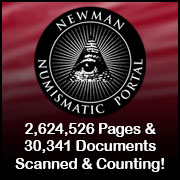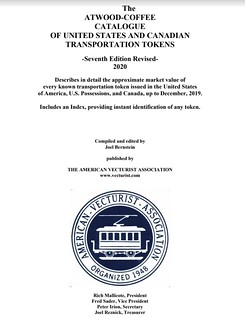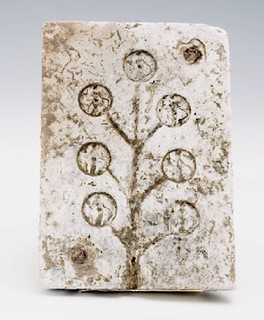
About UsThe Numismatic Bibliomania Society is a non-profit association devoted to the study and enjoyment of numismatic literature. For more information please see our web site at coinbooks.org SubscriptionsThose wishing to become new E-Sylum subscribers (or wishing to Unsubscribe) can go to the following web page link MembershipThere is a membership application available on the web site Membership Application To join, print the application and return it with your check to the address printed on the application. Print/Digital membership is $40 to addresses in the U.S., and $60 elsewhere. A digital-only membership is available for $25. For those without web access, write to: Charles Heck, Treasurer
AsylumFor Asylum mailing address changes and other membership questions, contact Chuck at this email address: treasurer@coinbooks.org SubmissionsTo submit items for publication in The E-Sylum, write to the Editor at this address: whomren@gmail.com BUY THE BOOK BEFORE THE COINSale Calendar |
- WAYNE'S WORDS: THE E-SYLUM FEBRUARY 16, 2020
- THE BIRMINGHAM ASSAY OFFICE LIBRARY SALE
- NEW BOOK: "ERRORS AND VARIETIES" REPRINTS
- NEW BOOK: ATWOOD-COFFEE CATALOGUE, 2020 EDITION
- NEW BOOK: BANK NOTES AND SHINPLASTERS
- NEW BOOK: THE ROLE OF MONEY IN WARTIME
- BANKNOTE BOOK NEWFOUNDLAND CHAPTER PUBLISHED
- BOOK REVIEW: THE MAN IN THE RED COAT (DR. POZZI)
- NEWMAN NUMISMATIC PORTAL BEGINNER’S GUIDE
- VIDEO: 1715 FLEET SOCIETY DIRECTOR BEN COSTELLO
- 1792 SILVER DISME PROJECT ANNOUNCEMENT
- JOSEPH LOVELL WRIGHT JR: PEACE MEDAL DESIGNER?
- CORRECTIONS: GROUVILLE HOARD DETAILS
- NOTES FROM E-SYLUM READERS: FEBRUARY 16, 2020
- AM I NOT A MAN AND A BROTHER TOKEN PEDIGREES
- BANK OF NEW YORK FUGIO CENTS IN LUCITE
- U.S. MINT 'HOW TO MAKE A PENNY' BROCHURES
- VOCABULARY TERMS: INSCRIBE, INSCRIBING
- KARL "CHARLES" J. H. FUELSCHER (1863-1936)
- HARVEY STACK'S NUMISMATIC FAMILY, PART 63
- CALL FOR PAPERS: 2020 SUNDMAN SERIES
- SAN FRANCISCO MINT STRIP CAST / SHEARED INGOTS
- BLYTHBURGH HOARD DECLARED TREASURE
- 1830 TEMPLETON REID 2 1/2 DOLLAR GOLD OFFERED
- PATTERN COINS FROM CHARLES BARBER ESTATE
- ROYAL MINT DINOSAUR COINS
- MEDIALIA EXHIBITS MASHIKO'S MEDALLIC SCULPTURE
- CHINA DISINFECTS BANKNOTES TO STOP COVID-19
- LOOSE CHANGE: FEBRUARY 16, 2020
Click here to access the complete archive
Click here to unsubscribe (scroll down)
To comment or submit articles, reply to whomren@gmail.com
Content presented in The E-Sylum is not necessarily researched or independently fact-checked, and views expressed do not necessarily represent those of the Numismatic Bibliomania Society.
WAYNE'S WORDS: THE E-SYLUM FEBRUARY 16, 2020
 New subscribers this week include: Barry Sunshine and David Manivitz, courtesy of Jim Neiswinter; and Mazen Mira. Welcome aboard! We now have 6,087 subscribers.
New subscribers this week include: Barry Sunshine and David Manivitz, courtesy of Jim Neiswinter; and Mazen Mira. Welcome aboard! We now have 6,087 subscribers.
Thank you for reading The E-Sylum. If you enjoy it, please send me the email addresses of friends you think may enjoy it as well and I'll send them a subscription (but let me know if they are located in the European Union). Contact me at whomren@gmail.com anytime regarding your subscription, or questions, comments or suggestions about our content.
This week we open with a numismatic literature sale, six new books, updates from the Newman Numismatic Portal, and a report on the 1792 Dime Project.
Other topics this week include hidden engraver signatures, the Grouville and Blythburgh hoards, Fugio cents encased in Lucite, U.S. Mint visitor brochures, Women in Numismatics, pattern coins from the Charles Barber estate, and the Royal Mint's dinosaur coins.
To learn more about the Birmingham Assay Office, engraver William Wyon, error coins, shinplasters, money in wartime, Boardman Silversmiths, the the Snyder Collection at the Truman Library, the man in the red coat and the Little Frenchman and His Bank Notes, read on. Have a great week, everyone!
Wayne Homren
Editor, The E-Sylum
THE BIRMINGHAM ASSAY OFFICE LIBRARY SALE
Antiquarian bookseller Forum Auctions in London is offering the Birmingham Assay Office Library on March 26, 2020. Included are a number of numismatic titles as well as some books from the library of Matthew Boulton. -Editor
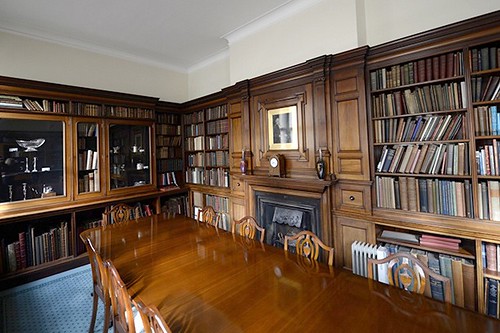
The Statute of 1300 allowed the Wardens of the Company of Goldsmiths in London to go out to workshops in the City and assay silver and gold. However, only silver that met the required standard was marked at this time. The mark was the symbol of the leopard’s head which is still the mark of the London Assay Office today. Gradually gold came to be marked in the same way as silver.
Quite some time after, in 1478, the Wardens of Goldsmiths set themselves up in Goldsmiths Hall and paid a salaried assayer to test and mark items submitted to them. This led to the introduction of the date letter in order to make successive assayers accountable for their work.
Birmingham Assay Office was founded by an Act of Parliament in 1773. It had become clear by this time to the silversmiths of Birmingham, especially Matthew Boulton, that their trade would never truly prosper without an Office of their own. Boulton lobbied Parliament vigorously and was finally rewarded by the Hallmarking Act 1773, which founded the Birmingham Assay Office.
For more information on the Birmingham Assay Office, see: THE STORY OF ASSAY OFFICE BIRMINGHAM (https://theassayoffice.com/assay-office-birmingham/the-story-of-assay-office-birmingham)
Here are a few selections from the sale. -Editor
Lot 2: Act to prohibit the Importation of light silver coin
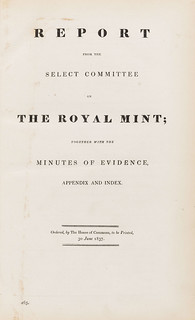 Act (An) to prohibit the Importation of light silver coin of this realm from Foreign Countries into Great Britain or ireland, Charles Eyre and William Strahan, 1774; and 23 others, acts
(24)
Act (An) to prohibit the Importation of light silver coin of this realm from Foreign Countries into Great Britain or ireland, Charles Eyre and William Strahan, 1774; and 23 others, acts
(24)
Act (An) to prohibit the Importation of light silver coin of this realm from Foreign Countries into Great Britain or Ireland, title with woodcut arms, crude tape repairs at head, 20th century calf-backed cloth, Charles Eyre and William Strahan, 1774 § Report from the Select Committee on The Royal Mint, 7 folding lithographed plates, 1837 bound with Report from the Royal Commission on International Coinage, 1868, contemporary half morocco, rubbed; and 22 others, mostly 19th / 20th century acts, v.s. (24)
To read the complete lot description, see:
Act (An) to prohibit the Importation of light silver coin of this realm from Foreign Countries into Great Britain or ireland
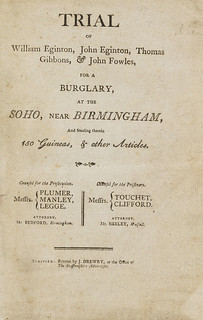 Boulton (Matthew).- Trial of William Eginton, John Eginton, Thomas Gibbons, & John Fowles : for a burglary, at the Soho, near Birmingham, and stealing therein 150 guineas, & other
articles, etc., final f. laid down, 20th century morocco-backed cloth, 8vo, Stafford, J. Drewry, 1801.
Boulton (Matthew).- Trial of William Eginton, John Eginton, Thomas Gibbons, & John Fowles : for a burglary, at the Soho, near Birmingham, and stealing therein 150 guineas, & other
articles, etc., final f. laid down, 20th century morocco-backed cloth, 8vo, Stafford, J. Drewry, 1801.
Rare, Library Hub lists two other copies only (BL and University of Manchester).
The accused were alleged to have robbed the counting house at Boulton's Soho Manufactory and were found guilty.
Interesting historical episode at Boulton's famous Birmingham operation. -Editor
To read the complete lot description, see:
Boulton (Matthew).- Trial of William Eginton, John Eginton, Thomas Gibbons, & John Fowles
Lot 95: Memoir of William Wyon
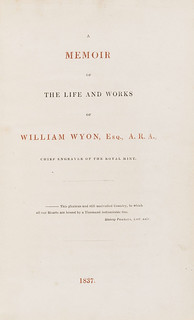 Economics.- [Carlisle (Nicholas)]A Memoir of the Life and Works of William Wyon, Chief Engraver of the Royal Mint, 2 parts in 1, titles in red and black, engraved portrait frontispiece, 2
A.Ls.s. by the author inserted (one mounted, one tipped in), pencil portrait of Carlisle by Leonard Charles Wyon, dated Dec. 16th 1842, stained and mounted on an inserted leaf, and A.L.s. by Thomas
Wyon tipped in, some foxing, contemporary half calf, spine gilt, Privately Printed, 1837; and 8 others on the Royal Mint, v.s. (9)
Economics.- [Carlisle (Nicholas)]A Memoir of the Life and Works of William Wyon, Chief Engraver of the Royal Mint, 2 parts in 1, titles in red and black, engraved portrait frontispiece, 2
A.Ls.s. by the author inserted (one mounted, one tipped in), pencil portrait of Carlisle by Leonard Charles Wyon, dated Dec. 16th 1842, stained and mounted on an inserted leaf, and A.L.s. by Thomas
Wyon tipped in, some foxing, contemporary half calf, spine gilt, Privately Printed, 1837; and 8 others on the Royal Mint, v.s. (9)
Important biographical source for one of the world's most famous and prolific coin engravers. -Editor
To read the complete lot description, see:
[Carlisle (Nicholas)]A Memoir of the Life and Works of William Wyon, Chief Engraver of the Royal Mint
Lot 161: Original Sketches for Medals
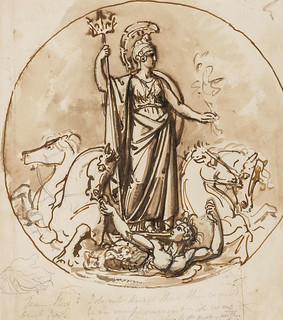
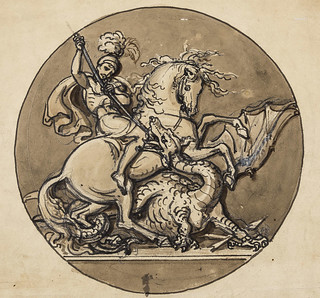
Flaxman (John, sculptor and draughtsman, 1755-1826), Wyon (William, chief engraver at the Royal Mint, between 1830 and 1850, 1795-1851) and others. Original Sketches for Medals, Seals, &c., 151 original drawings, 2 vol., vol. I with 81 drawings and watercolours by various hands [see list below], and vol. II with 65 drawings by various hands [see below], vol. I predominantly with designs for seals, medals, and coins, including over 30 drawings by and attributed to William Wyon, vol. II with medals and 44 original drawings by John Flaxman for cups, candelabra, ornamental friezes and of figural compositions, pen and inks, watercolours, pencil and chalks, all on various contemporary papers, neatly hinged onto thick album leaves, most bearing pencil attributions verso and on mounts, album leaves each approx.. 390 x 290 mm. (15 ¼ x 11 ½ in), one leaf lacking a drawing, otherwise complete, another drawing loose from album leaf, occasional spotting, browning, surface dirt and handling creases, half red morocco, marbled boards, spine gilt, one vol. with inside upper cover coming loose, rubbed and scuffed, folio, [probably compiled circa 1830-1850]
Provenance:
Possibly part ex-collection of William Wyon (1795-1851), or a descendant [for discussion of Wyon's relationship to John Flaxman, see Mark Jones, William Wyon as a Pupil and Follower of Flaxman,
from 'Burning Bright: Essays in Honour of David Bindman', pp. 89-97, UCL Press, 2015]
Literature:
Westwood, Arthur [compiled by], Catalogue of the Books in the Library at the Assay Office Birmingham, 1914, p. 301; described as 'Two folio volumes in which are inserted original sketches and
designs for coins, medals, etc., by William Wyon, Sir Thomas Lawrence, ... Thomas Stothard ..., and John Flaxman.'
Drawing highlights contained within vol. I include:
- Sir Thomas Lawrence (1769-1830) Head of Minerva, design for a seal, pencil, 110 x 48 mm. (4 ¼ x 1 ¾ in)
- Sir Francis Legatt Chantrey (1781-1841) Profile portrait of William IV, design for a coin, pencil, 225 x 190 mm. (8 ¾ x 7 ½ in)
- William Dyce (1806-1864) Six sheets of designs for crown pieces or florins, various sizes
- E. Corbould (1815-1905) Over 30 sheets of coin and medal designs attributed to E. Corbould, possibly [?] Henry Corbould (1787-1844), various sizes
- William Wyon (1795-1851) Over 30 sheets of portraits, some of personal interest to the artist, others designs for coins and medals, various sizes
What an amazing artifact! -Editor
To read the complete lot description, see:
Flaxman (John, sculptor and draughtsman, 1755-1826), Wyon (William, chief engraver at the Royal Mint, between 1830 and 1850, 1795-1851) and others. Original Sketches for Medals, Seals,
&c.
Lot 247: The Knowledge of Medals
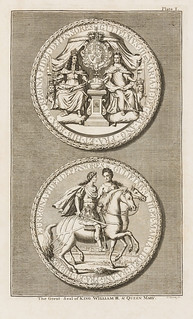 Numismatics.- Medals.- Jobert (Louis)The Knowledge of Medals, [translated by Roger Gale], first English edition, contemporary calf, rebacked, later endpapers, [Wing J755], for Williams
Rogers, 1697 § Jennings (David) An Introduction to the Knowledge of Medals, second edition, contemporary half calf, rebacked, [cf. Gaskell 28], Birmingham, Sarah Baskerville, 1776 § The Metallick
History of the Reigns of King William III. and Queen Mary, 37 engraved plates, upper hinge weak, original boards, rebacked, corners worn, for John and Paul Knapton, 1747; and 10 others, medals, 8vo
& folio (13)
Numismatics.- Medals.- Jobert (Louis)The Knowledge of Medals, [translated by Roger Gale], first English edition, contemporary calf, rebacked, later endpapers, [Wing J755], for Williams
Rogers, 1697 § Jennings (David) An Introduction to the Knowledge of Medals, second edition, contemporary half calf, rebacked, [cf. Gaskell 28], Birmingham, Sarah Baskerville, 1776 § The Metallick
History of the Reigns of King William III. and Queen Mary, 37 engraved plates, upper hinge weak, original boards, rebacked, corners worn, for John and Paul Knapton, 1747; and 10 others, medals, 8vo
& folio (13)
To read the complete lot description, see:
Jobert (Louis)The Knowledge of Medals, [translated by Roger Gale], first English edition
Lot 271: Amendment of the Silver Coins
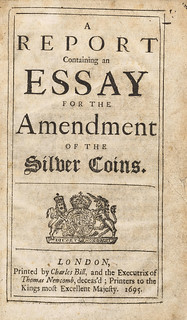 [Lowndes (William)]A Report Containing an Essay for the Amendment of the Silver Coins, only edition, title soiled, later mottled calf, gilt, upper joint rubbed, [Wing L3323; Goldsmiths'
3131; Kress 1909], by Charles Bill, and the Executrix of Thomas Newcomb, 1695 § [Pratt (Samuel)] The Regulating Silver Coin, first edition, [Wing P3184; Goldsmiths' 3331], for Henry Bonwick,
1696; bound with J. (R.) A Letter of Advice to a Friend about the Currency of Clipt-Money, second edition, foxing, [Wing J29A], for Edw. Castle, 1696, together 2 works in 1, contemporary calf,
rebacked, rubbed § Some Considerations about the Raising of Coin. In a Second Letter to Mr. Locke, first edition,half-title, final leaf with date "Octob. the 3d. 1696" and advertisements
beneath, some foxing, later cloth-backed boards, soiled, [Wing S4481], for A. and J. Churchill, 1696, 8vo (3)
[Lowndes (William)]A Report Containing an Essay for the Amendment of the Silver Coins, only edition, title soiled, later mottled calf, gilt, upper joint rubbed, [Wing L3323; Goldsmiths'
3131; Kress 1909], by Charles Bill, and the Executrix of Thomas Newcomb, 1695 § [Pratt (Samuel)] The Regulating Silver Coin, first edition, [Wing P3184; Goldsmiths' 3331], for Henry Bonwick,
1696; bound with J. (R.) A Letter of Advice to a Friend about the Currency of Clipt-Money, second edition, foxing, [Wing J29A], for Edw. Castle, 1696, together 2 works in 1, contemporary calf,
rebacked, rubbed § Some Considerations about the Raising of Coin. In a Second Letter to Mr. Locke, first edition,half-title, final leaf with date "Octob. the 3d. 1696" and advertisements
beneath, some foxing, later cloth-backed boards, soiled, [Wing S4481], for A. and J. Churchill, 1696, 8vo (3)
To read the complete lot description, see:
A Report Containing an Essay for the Amendment of the Silver Coins
Lot 354: Preventing the Forgery of Bank Notes
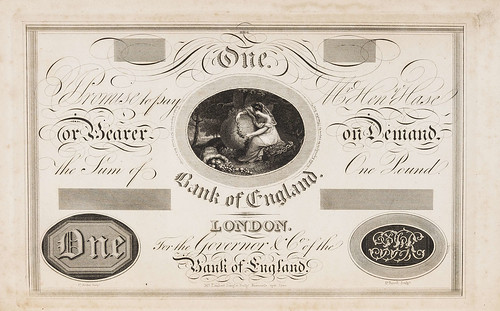
Report of the Committee of the Society of Arts...Relative to the Mode of Preventing the Forgery of Bank Notes, half-title, 6 engraved plates (1 folding), some foxing to plates, a few small stains, [Goldsmith 22503; Kress C.414], 20th century half morocco, spine gilt, 1819; and Ibbetson on an invention to prevent forgery of bank notes, 8vo (2)
An important work on banknote engraving. -Editor
To read the complete lot description, see:
Report of the Committee of the Society of Arts...Relative to the Mode of Preventing the Forgery of Bank Notes
Lot 424: A discourse of coin and coinage
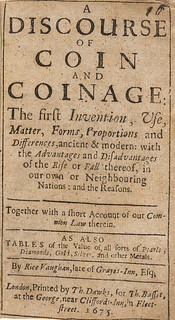 Numismatics.- Coins.- Vaughan (Rice) A discourse of coin and coinage: the first invention, use, matter, forms, proportions and differences, ancient & modern: with the advantages
and disadvantages of the rise or fall thereof, in our own or neighbouring nations: and the reasons, first and only edition, woodcut head-pieces and decorative initial, preliminaries lightly browned,
trimmed at head, affecting some headlines, occasional spotting, later speckled calf, rebacked, [Wing V131; Goldsmiths 2131; Kress 1394], 12mo, printed by Th. Dawks, for Th. Basset, at the George,
near Cliffords-Inn, in Fleet-street, 1675.
Numismatics.- Coins.- Vaughan (Rice) A discourse of coin and coinage: the first invention, use, matter, forms, proportions and differences, ancient & modern: with the advantages
and disadvantages of the rise or fall thereof, in our own or neighbouring nations: and the reasons, first and only edition, woodcut head-pieces and decorative initial, preliminaries lightly browned,
trimmed at head, affecting some headlines, occasional spotting, later speckled calf, rebacked, [Wing V131; Goldsmiths 2131; Kress 1394], 12mo, printed by Th. Dawks, for Th. Basset, at the George,
near Cliffords-Inn, in Fleet-street, 1675.
'The first historical monograph in English on money' (Palgrave). The lawyer Rice Vaughan held various public offices in Wales before being imprisoned in the Tower of London in 1665 for two years. This work was published posthumously by Henry Vaughan ('the Silurist', 1621-1695), poet and writer of devotional prose.
To read the complete lot description, see:
A discourse of coin and coinage
Lot 1: The Quarters of William Stayley
Lot No. 1 is non-numismatic despite the word "quarters" in the title - it's a grisly tale of the last decapitated head to be displayed on London Bridge.
The entire sale is well worth browsing just for fun. Subjects include alchemy, metallurgy, mining, weights & measures, chemistry, electrotyping, heraldry, jewellery, economics, horology, and science & technology.
But why is this marvelous library being broken up and sold in the first place? That seems an awful shame. A delight for collectors of course, but a loss to the world at large. -Editor
To read the complete lot description, see:
Account (An) of the digging up of the quarters of William Stayley

NEW BOOK: "ERRORS AND VARIETIES" REPRINTS
Canadian Coin News columnist John Regitko has published a reprint volume of his writings on errors and varieties. Thanks for making this resource available. Here are the details. -Editor
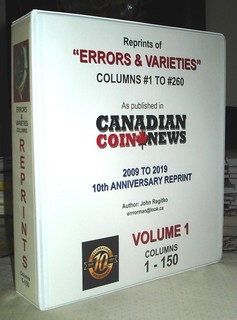 I want to make E-Sylum subscribers aware of the fact that after writing the “Errors & Varieties” column in Canadian Coin News for the past ten years, I have reprinted the
260 columns in letter-size format, 3-ring punched, ready to be inserted into binders.
I want to make E-Sylum subscribers aware of the fact that after writing the “Errors & Varieties” column in Canadian Coin News for the past ten years, I have reprinted the
260 columns in letter-size format, 3-ring punched, ready to be inserted into binders.
Since the minting presses used at the U.S. Mint are the same as used at the Royal Canadian Mint, the information as to the causes of all types of errors is also of interest to collectors of U.S. errors.
I have conducted interviews with various key personnel at the Royal Canadian Mint going back to the 1960s, obtaining firsthand information directly. Access to the production floor enabled me to keep up-to-date on new equipment that affects the type of errors that could occur.
The 1,300+ pages, of which a full half are in colour, require either two 2” binders or three 1-1/2” binders. Colour sheets for the front, back and spine are included for insertion into your binders with slip-in covers.
Many of the earlier columns that were published in black & white are reprinted in colour. Out of the 3,000 photos, nearly half are in colour.
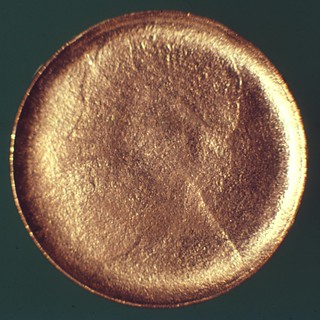 As the unveiling of the 260 columns comes after a bit of a delay, I am pleased to include a further 20 columns (#261 to #280) totalling another 80 pages, mostly in colour.
As the unveiling of the 260 columns comes after a bit of a delay, I am pleased to include a further 20 columns (#261 to #280) totalling another 80 pages, mostly in colour.
If you do some calculating on the cost of printing a total of nearly 600 colour and 750 black & white pages, the price for the package is very reasonable at $70 US plus $20 US shipping to anywhere in the Continental USA via USPS in their standard medium size mailer box.
Due to the weight of over 9 lbs., to keep the cost reasonable, orders have to be received by the beginning of April. The package will be shipped when I am in Ohio around Easter. If orders are received after that time, the shipping charge will be increased to the considerably higher cost from Canada.
Cheques or money orders in the total amount of $90 US ($74 for the set of reprints; $16 for shipping), payable to the author, should be sent to: John Regitko, 147 - 4936 Yonge St., NORTH YORK, Ontario M2N 6S3.
If any E-Sylum subscriber orders the package and is not happy with the contents, they can return the package to an Ohio address within a reasonable period of time and I will issue them a full refund plus half of their return shipping cost.
For the full press release, please contact me at errorman@look.ca.
Thank you for making this great resource available, particularly with the improved photos. Here are some examples (shown at lower resolution for online consumption) - great photos of some great errors. -Editor
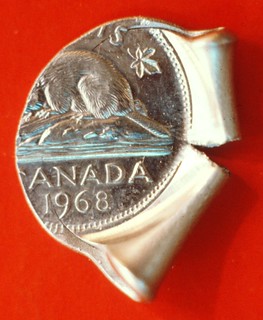
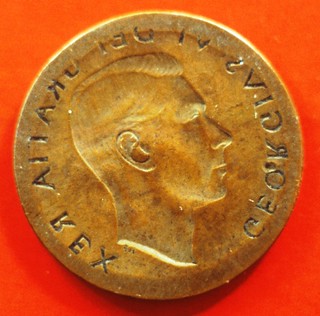
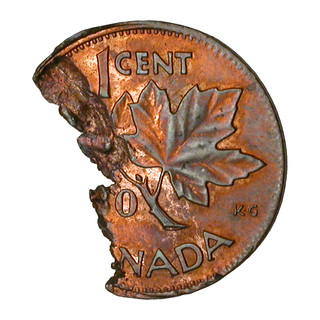
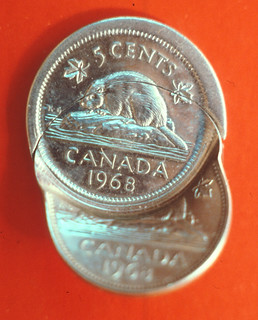
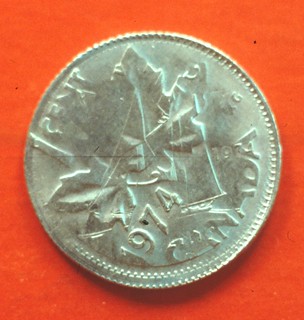
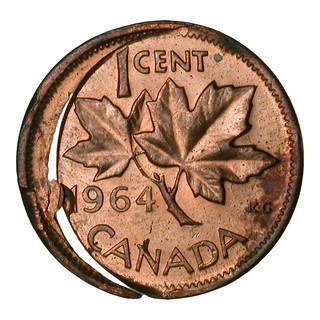

NEW BOOK: ATWOOD-COFFEE CATALOGUE, 2020 EDITION
"For more than fifty years The Atwood-Coffee Catalogue has been the comprehensive listing of United States and Canadian Transportation Tokens. The 2020 seventh edition revised is now available in a PDF format, and you can't beat the price. It's free to all members of the American Vecturist Association. A digital, worldwide membership in the AVA is US $10 and includes The Fare Box monthly newsletter. Use the linked application form and email to Mr. Peter Irion, AVA Secretary: petervt@aol.com
Great offer! Here's the link to the application:
http://www.vecturist.com/downloads/AVA%20Membership%20Application.pdf
-Editor
NEW BOOK: BANK NOTES AND SHINPLASTERS
Bob Leonard alerted me to this new book by Joshua R. Greenberg on banknotes and shinplasters in the U.S. Thanks! -Editor
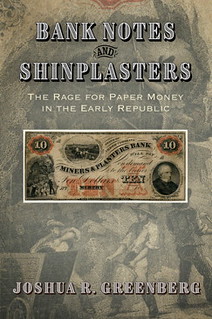 Bank Notes and Shinplasters
Bank Notes and Shinplasters
The Rage for Paper Money in the Early Republic
Joshua R. Greenberg
264 pages | 6 x 9 | 28 illus.
Cloth Jun 2020 | ISBN 9780812252248 | $34.95a | Outside the Americas £28.99
Ebook editions are available from selected online vendors
A volume in the series American Business, Politics, and Society
"Prior to the Civil War, thousands of different, ornately engraved bank notes supplied most of the money in circulation. In marvelous detail, Joshua R. Greenberg takes us back to the anxieties of that era. He deftly examines how every single cash transaction was shot through with uncertainty and arbitrage, as ordinary citizens struggled with the perils of counterfeit notes, fluctuating exchange rates, and worthless paper. In his revealing reconstruction of a monetary world long lost to us, Greenberg ultimately explains how these mundane exchanges shaped the seismic political events of the day, from the Bank War to the Civil War. A splendid book."—Stephen Mihm, author of A Nation of Counterfeiters "Joshua R. Greenberg skillfully provides a history of how everyone in the early American republic pushed, pondered, purloined, politicized, and polemicized the thousands of material objects that circulated as their money. Historiographically significant and beautifully written, Bank Notes and Shinplasters will be of interest to anyone interested in the history of capitalism."—Jessica Lepler, author of The Many Panics of 1837: People, Politics, and the Creation of a Transatlantic Financial Crisis
"In this persuasive and entertaining book, Joshua R. Greenberg shows that early republic Americans had their mind on their money and their money on their mind. They put bank notes—valuable and counterfeit, pristine and soiled—to mundane and surprising commercial, cultural, and political uses. Greenberg traces the circulation of these bills as material objects from bank vaults, to store tills, to consumers' pockets and back again. In so doing, he makes compelling use of them himself to register the contested economic and emotional meanings that these ubiquitous instruments had for Americans who held and passed them. I love this book."
—Brian Luskey, author of On the Make: Clerks and the Quest for Capital in Nineteenth-Century America
Before Civil War greenbacks and a national bank network established a uniform federal currency in the United States, the proliferation of loosely regulated banks saturated the early American republic with upwards of 10,000 unique and legal bank notes. This number does not even include the plethora of counterfeit bills and the countless shinplasters of questionable legality issued by unregulated merchants, firms, and municipalities. Adding to the chaos was the idiosyncratic method for negotiating their value, an often manipulative face-to-face discussion consciously separated from any haggling over the price of the work, goods, or services for sale. In Bank Notes and Shinplasters, Joshua R. Greenberg shows how ordinary Americans accumulated and wielded the financial knowledge required to navigate interpersonal bank note transactions. Locating evidence of Americans grappling with their money in fiction, correspondence, newspapers, printed ephemera, government documents, legal cases, and even on the money itself, Greenberg argues Americans, by necessity, developed the ability to analyze the value of paper financial instruments, assess the strength of banking institutions, and even track legislative changes that might alter the rules of currency circulation. In his examination of the doodles, calculations, political screeds, and commercial stamps that ended up on bank bills, he connects the material culture of cash to financial, political, and intellectual history.
The book demonstrates that the shift from state-regulated banks and private shinplaster producers to federally authorized paper money in the Civil War era led to the erasure of the skill, knowledge, and lived experience with banking that informed debates over economic policy. The end result, Greenberg writes, has been a diminished public understanding of how currency and the financial sector operate in our contemporary era, from the 2008 recession to the rise of Bitcoin.
Joshua R. Greenberg is the editor of Commonplace: the journal of early American life.
Here's an excerpt - see more online. This looks like a great book. I ordered a copy. -Editor
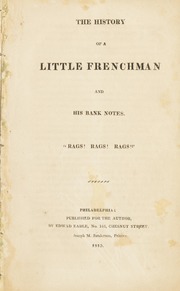 In his 1815 satire The History of a Little Frenchman and His Bank Notes: "Rags! Rags! Rags!," James Kirke Paulding told the story of a newly arrived and thoroughly confused
French visitor as he navigated the unique American paper money system. The Frenchman landed in Savannah from Cuba and deposited $8,000 in gold in a local bank. However, they offered only bank notes
when he tried to withdraw the funds. He assumed that, like Banque de France notes, the bills were a convenient stand-in for gold or silver and circulated at face value. So, "ignorant of the
depreciation of paper money, arising from the refusal to pay specie [coined gold or silver], and from the erection of such an infinite number of petty banks in every obscure village without capital
or character, he took the worthless rags" and set out for Boston.
In his 1815 satire The History of a Little Frenchman and His Bank Notes: "Rags! Rags! Rags!," James Kirke Paulding told the story of a newly arrived and thoroughly confused
French visitor as he navigated the unique American paper money system. The Frenchman landed in Savannah from Cuba and deposited $8,000 in gold in a local bank. However, they offered only bank notes
when he tried to withdraw the funds. He assumed that, like Banque de France notes, the bills were a convenient stand-in for gold or silver and circulated at face value. So, "ignorant of the
depreciation of paper money, arising from the refusal to pay specie [coined gold or silver], and from the erection of such an infinite number of petty banks in every obscure village without capital
or character, he took the worthless rags" and set out for Boston.
Each of the Frenchman's subsequent transactions exposed the foreigner's inexperience with bank notes and shinplasters—paper money issued by nonbank entities like merchants or municipal corporations—because he could not discern which notes were good and which were worthless. In one typical episode, he offered to pay for a drink in a Bristol, Pennsylvania, tavern with a bill issued by the landlord of a Philadelphia hotel where he had previously stayed. His traveling companion explained that the hotelier, "in order to be in fashion, had also commenced Banker among the rest." Yet the Bristol landlord refused outright to accept the bill. The rejection upset the Frenchman; how was he to understand the difference between a note issued by a hotel operator or local postmaster and one from the Planters Bank of the State of Georgia?
The problem for the Frenchman was that he did not have enough monetary knowledge to understand how bank notes and shinplasters actually worked, so he blindly received all of them equally. American paper money was more complicated than that. Though at first glance different bills might appear similar, some circulated at face value, others passed only with a discount, and a final group were accepted as currency only by their issuer.
For more information, or to order, see:
Bank Notes and Shinplasters The Rage for Paper Money in the Early Republic (https://www.upenn.edu/pennpress/book/16082.html)
Table of contents and excerpt: https://www.upenn.edu/pennpress/book/toc/16082_toc.html
To read The History of a Little Frenchman... on the Newman Numismatic Portal, see:
The History of a Little Frenchman and His Bank Notes (https://nnp.wustl.edu/library/book/558670)

NEW BOOK: THE ROLE OF MONEY IN WARTIME
This one was published back in 2018, but I recently ran across it while looking for other things. The Role of Money in Wartime is the published proceedings of the Second Conference of the Museum of the Bank of Albania. Here's an excerpt from the opening address. -Editor
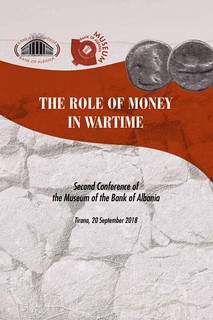 As the title suggests, this Conference will address the role of money in wartime. In periods of wars and conflicts - history shows that, albeit relatively small, Albania has experienced
many wars and conflicts - people have turned to the currency and precious metals. Hence, about 100 years ago, at the beginning of the World War I, Europe dived into one of the worst financial crises
of the past century and many people and businesses rushed to convert their bank accounts and assets into cash and gold coins.
As the title suggests, this Conference will address the role of money in wartime. In periods of wars and conflicts - history shows that, albeit relatively small, Albania has experienced
many wars and conflicts - people have turned to the currency and precious metals. Hence, about 100 years ago, at the beginning of the World War I, Europe dived into one of the worst financial crises
of the past century and many people and businesses rushed to convert their bank accounts and assets into cash and gold coins.
Meanwhile, in Albania, these events triggered a chaotic monetary circulation. In the absence of a national currency and due to the political military and economic developments during the War, diverse foreign currencies circulated across the country, mainly those of European and neighbouring countries, as well as American and Turkish ones.
You may see this conglomerate of denominations in the showcases of the Museum dedicated to the period of Independence and the World War I. Also, the showcases on the monetary circulation in Albania during World War II, in addition to the ones of Antiquity and Medieval periods, exhibit denominations that speak of the important and complicated relationships between money and war.
Here's an abbreviated table of contents. Something here for collectors and researchers in ancient coins, modern coins, and paper money. -Editor
- Minting of Illyrian coins in wartime
- Coinage and war in the territory of South Illyria (IV-I century BC)
- Coinage in ancient warrior exchange systems between Greeks and non-Greeks
- Byzantine Coins in Berat During the Byzantine-Anjevin Conflict (1258-1281)
- Data on Monetary Circulation in Drisht
- Albanian Captives, Pirates and privateers in the Mediterranean. Captivity and redemption of captives as an economic activity during the 16th-17th centuries.
- Economic and Monetary Policy in Albania during the Interwar Period
- The National Bank of Romania and Money Issues during World War One
- The National Bank of Albania, relations with central authorities, September 1943 - October 1944
- Western Europe or China? An economic interest assessment: why was Western Europe saved from communism by George Marshall at the beginning of the Cold War, 1945-1949, whereas Chiang Kai-shek’s nationalists were abandoned and left in the hands of Mao Zedong’s communists?
To read the complete book online, see:
https://www.bankofalbania.org/rc/doc/LIBRI_KONF_MUZEUT_2018
_anglisht_15837.pdf
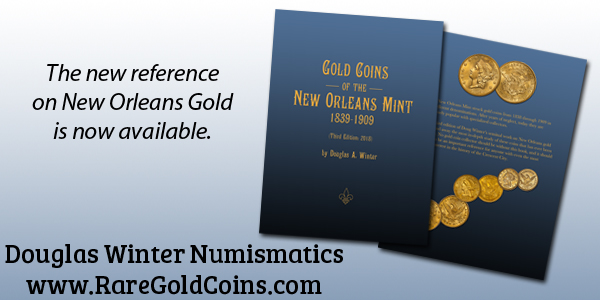
BANKNOTE BOOK NEWFOUNDLAND CHAPTER PUBLISHED
Owen Linzmayer publishes The Banknote Book, a useful, constantly updated electronic reference. On February 14, 2020 he announced via email the availability of the chapter on the banknotes of Newfoundland. It's available for $4.99. -Editor
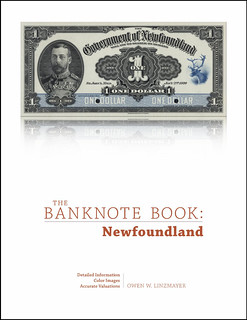 Newfoundland (North America)
Newfoundland (North America)
This 6-page catalog covers notes issued by the Island of Newfoundland in 1850 and the Newfoundland Government from 1901 to 1920. Published 11.02.2020.
Currently 285 chapters of The Banknote Book have been published as individual high-resolution PDF files. This represents a total of 6,309 pages covering 58,542 types and varieties.
For more information on The Banknote Book, see:
http://www.banknotenews.com/banknote_book/banknote_book.php
BOOK REVIEW: THE MAN IN THE RED COAT (DR. POZZI)
John Mellman passed along these comments inspired by a Wall Street Journal review of a book about the life of a famous coin collector - Dr. Samuel Pozzi. Thanks! -Editor
The Pozzi sale of April 1921 is one of the highlights of 20th century numismatic catalogues. The sale, catalogued by Jacob Hirsch and held at Naville & Cie. took place on Apr 4, 1921 and contained 3334 lots of Greek coins fully illustrated on 101 plates (I have an unplated copy of the catalogue). The catalogue is further described in Spring, Ancient Coin Auction Catalogues 1880-1980, pp. 174-175.
The Wall Street Journal (Feb. 15-16, 2020) contains a striking portrait of the collector, Samuel Jean Pozzi, “Dr. Pozzi at Home” (1881) by the painter John Singer Sargent, wearing a red (scarlet) robe (reminiscent of Baroque paintings of Popes and Cardinals). This was 40 years before the sale. The illustration accompanies a book review of Julian Barnes’ book “The Man in the Red Coat” by Sue Roe. I have read the review but not the book, which is just out.
There is in fact no specific mention in the article of Pozzi’s collecting interests, but rather of his medical achievements, celebrity and celebrity associates as a “man about town", and contradictory character. He was a pioneering gynecologist when the specialty was coming to be separate from general medicine, and the President of France was present at the opening of his modernized hospital in 1899. He emphasized care and consideration for the patient. His friends and associates included Oscar Wilde, Sarah Bernhardt, and a host of Proustian aristocrats. While the reviewer states “no spoilers” about how Pozzi died, that is well covered in Spring, page 175.
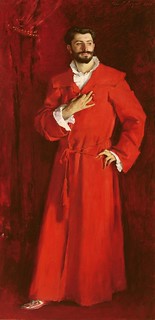
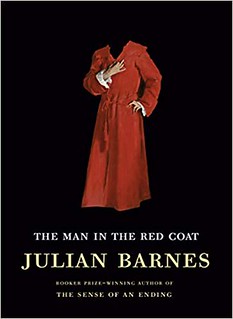
Thanks! Shown above are the Sargent painting and cover of the book. The Newman Numismatic Portal has multiple references to Pozzi and his sale. I would also refer readers to "The Life of Samuel Pozzi" by Shanna Schmidt in the Winter 2016 Asylum. -Editor
To read the complete WSJ article (subscription required), see:
‘The Man in the Red Coat’ Review: The Toast of Belle Époque Paris
(https://www.wsj.com/articles/the-man-in-the-red-coat-review-the-toast-of-belle-epoque-paris-11581695454)

NEWMAN NUMISMATIC PORTAL BEGINNER’S GUIDE
The latest addition to the Newman Numismatic Portal is an excellent Beginner’s Guide video. Project Coordinator Len Augsburger provided the following report. -Editor
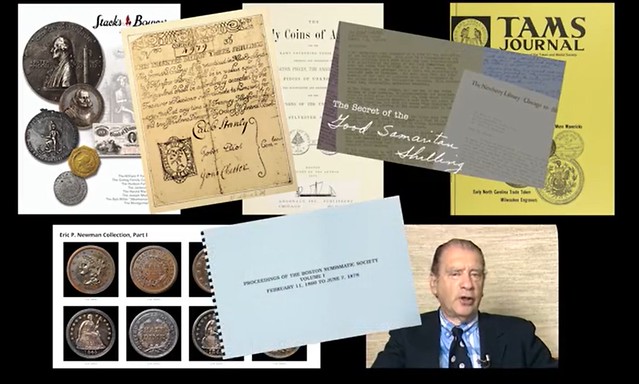
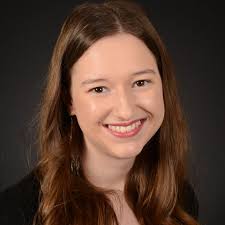 With over 30,000 documents and 2,500 videos, the Newman Portal content can be at first daunting. Lianna Spurrier makes sense of it all with her recent video “Newman Numismatic Portal
Beginner's Guide.” Newman Portal divides library material into several major categories – auction catalogs, periodicals, books, archives, etc.
With over 30,000 documents and 2,500 videos, the Newman Portal content can be at first daunting. Lianna Spurrier makes sense of it all with her recent video “Newman Numismatic Portal
Beginner's Guide.” Newman Portal divides library material into several major categories – auction catalogs, periodicals, books, archives, etc.
Auction catalogs are divided by auction house, with nearly 10,000 sale catalogs representing several hundred auction firms. Periodicals cover anything from state and regional organizations to well-known titles such as The Numismatist and the American Journal of Numismatics. The archive section includes a quarter million pages of U.S National Archives & Records Administration (NARA) material, categorized by the NARA record group and entry classifications. In addition to library holdings, Newman Portal includes an image and biographical database, based on Pete Smith’s American Numismatic Biographies. Spurrier breaks it down further with additional examples in this useful video.
Link to Newman Portal Beginner’s Video:
https://nnp.wustl.edu/library/book/577584
VIDEO: 1715 FLEET SOCIETY DIRECTOR BEN COSTELLO
These are selections from the David Lisot Video Library that feature news and personalities from the world of coin collecting. David has been attending coin conventions since 1972 and began
videotaping in 1985. The Newman Numismatic Portal now lists all David’s videos on their website at:
https://nnp.wustl.edu/library/multimediadetail/522852
Here's one with 1715 Fleet Society Director Ben Costello. -Editor
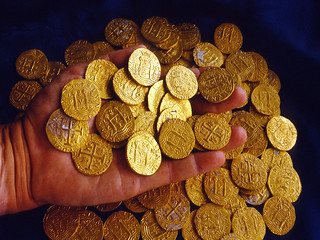 1715 Fleet Society Plans Convention in Havana, Cuba March 23-27, 2020. VIDEO: 4:55.
1715 Fleet Society Plans Convention in Havana, Cuba March 23-27, 2020. VIDEO: 4:55.
Ben Costello, Director, 1715 Fleet Society, David Lisot, Interviewer, CoinTelevision.com.
The 1715 Fleet Society is all about treasure. Their third conference is taking place in Havana, Cuba. Find out about the society and the upcoming Havana trip March 23-27, 2020 coordinated by ASC International USA, contact person, Dana Reed, 813-319-7095.
An excerpt of the video is available for viewing on the Coin Television YouTube Channel at:
https://youtu.be/ZadJxOlKlTA

1792 SILVER DISME PROJECT ANNOUNCEMENT
Rob Rodriguez and Tony Lopez submitted this announcement of progress in their intensive 1792 Silver Disme project. -Editor
After nearly four years of research, the 1792 Silver Disme project is nearing completion. To complete this project, in January, the Resolute Americana Collection acquired the lone 1792 silver disme it did not own, the Judd-9a thick planchet. As such, for the first time since the 1792 Mint, all three 1792 silver dismes reside in one collection. Nearly $1.9 million was expended to acquire the necessary coins for this research study.

Since early 2016, the team of Rob Rodriguez and Tony Lopez has been studying the Judd-9, F15 NGC, thin planchet silver disme. For over 150 years, it has been described as “marked-up,” “scratched,” or “graffiti.” When I first saw this coin, the etch marks conveyed something totally different to me and I believed they reflected a hidden story. To unravel this mystery, Tony Lopez joined the research effort and brought his considerable photographic talents to it.
The Judd-9 F15 has been subjected to approximately 1,000 hours of study that includes over 150 hours of photographic analysis, 55 hours of scanning electron microscope (SEM) analysis, utilizing two different types of SEMs, and, finally, over 470 hours of X-ray diffraction at the Argonne National Laboratory Advanced Photon Source (APS) synchrotron.
The APS is one of the premiere synchrotron particle accelerators in the world. After an application process that took several months, this project was accepted — a first for numismatics. As a result of its success, this project demonstrates how high intensity X-ray diffraction can be utilized upon rare metallic antiquities without fear of harm to them. It can recover information that was previously thought to be permanently lost.
In four visits to the APS in 2018 and 2019, we were able to recover accurate images of virtually 100% of the lost or disfigured surface markings from a depth of approximately 20-25 microns. These etch marks were burnished away or distorted by Edward Cogan’s attempt to “improve” the surface appearance of the coin. In January 1864, the coin was sold to Mr. Edward Seavey for the incredible sum of $205 and it has been included among some of the great numismatic collections since 1864, including: Lorin Parmelee; H.O. Granberg; Waldo Newcomer; “Col.” E.H.R. Green; Eric Newman and Burdette G. Johnson; Floyd T. Starr and Bob Simpson.
This April, we will be returning to the Argonne APS to subject the Judd-9a to X-ray diffraction testing. Dr. Wenjun Liu believes two visits may be required to scan all the necessary areas. We believe this coin, with its obverse tooling marks in front of Liberty and the removal of its date, may have been part of the design work surface process that we have been investigating. We hope to recover the lost information that may provide additional insights about both coins.
Soon, Tony Lopez and I will begin the process of memorializing the research conducted and its discoveries, in a paper titled, “History Recovered, Saga of the 1792 Silver Disme.” We believe the numismatic community and the general public will find this story and its conclusions to be quite fascinating. Our journey of discovery took many twists and turns, with several challenges along the way, before achieving a successful outcome.
Special thanks and appreciation go out to the staff of the Argonne National Laboratory for their incredible support of this project. In particular, we could not have attained a successful outcome without the incredible talents of three physicists, Dr. Wenjun Liu, Dr. Jon Tischler and Dr. Ruqing Xu, who conducted the X-ray diffraction testing. The Argonne National Laboratory is an American treasure where leading edge scientific investigations occur every day.


Argonne National Laboratory and the Advanced Photon Source
We'll look forward to seeing the final results! -Editor

JOSEPH LOVELL WRIGHT JR: PEACE MEDAL DESIGNER?
Reader Gary C. Gianotti submitted this summary of his research into the maker of a recently discovered silver oval George Washington Indian Peace Medal discussed in The Colonial Newsletter #159 (December 2015). See the link below to read the full article by Gary and Ron Miller and subsequent reactions by Bill Nyberg and others. -Editor
Identification of the only two known 1792 hallmarked medals the “Wright” way
Gary C. Gianotti FSA Scot
Back in 2011, numismatic, exonumia pioneer and authority of hand engraved George Washington silver oval Indian peace medals George Fuld had made one of his last great discoveries before passing in 2013. While he was coauthoring the Gilcrease Musuem’s peace medals exhibit book “Peace Medals, Negotiating Power in Early America”, George with the coauthors presented his discovery of the Woolaroc Museum, GW Indian Peace medal on the front cover of the book. Adding a write up on the medal's discovery in the book, George describes the medal as a very important discovery of an unknown silversmith, who hallmarked the medal “JW” - he medal being the only hallmarked 1792 specimen medal known to exist, of all 1792 GW silver oval IPM’s that are known to be authentic, with it possibly being made by a silversmith named Joseph Wyatt! Coin World published the story Nov, 30th 2011 on the book, regarding the Gilcrease Museums Peace medal exhibit. Coin World wrote a paragraph in the article about George's discovery of the Woolaroc medal being featured on the book cover and George’s discovery of this unknown hallmarked medal.
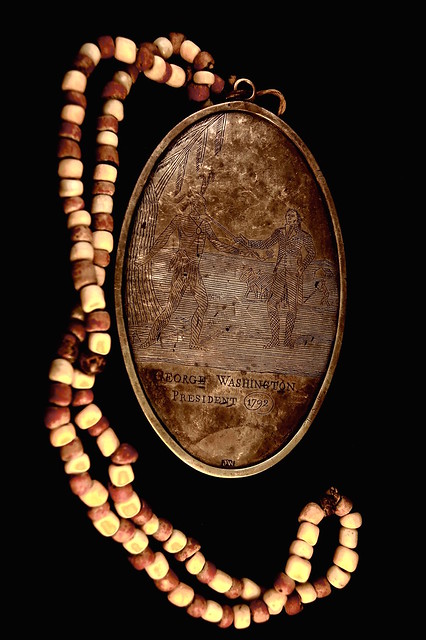 After George’s passing in 2013, a near identical medal to the Woolaroc had surfaced. The medal having been acquired from upstate NY that was featured in the ANS “Colonial Newsletter”
12/1/15 CNL-159. Scholars were skeptical of our new research involving hidden makers marks left by the guild engravers on all peace medals that have written cipher messages, esoteric symbolism,
hidden makers initials and much more. Since then, both the Woolaroc and its nearly identical NY twin sister medal, have become the two most studied specimens producing the most significant finds that
have advanced the study of these rare medals.
After George’s passing in 2013, a near identical medal to the Woolaroc had surfaced. The medal having been acquired from upstate NY that was featured in the ANS “Colonial Newsletter”
12/1/15 CNL-159. Scholars were skeptical of our new research involving hidden makers marks left by the guild engravers on all peace medals that have written cipher messages, esoteric symbolism,
hidden makers initials and much more. Since then, both the Woolaroc and its nearly identical NY twin sister medal, have become the two most studied specimens producing the most significant finds that
have advanced the study of these rare medals.
George was mistaken on the possibility of the silversmith being Joseph Wyatt of London. Wyatt never stepped foot in America until after 1793 as original assayer records state, as well as documented 1793 Wyatt pieces specify. Researcher David Fegley of Pennsylvania had examined the N.Y. specimen under a digital microscope and discovered that the hallmark “JW” is “JLW” with a clearly cut letter “J” between the “JL” & “W” that represents Joseph Lovell Wright Junior. The dash on the “J” is an “L” because dashes were not used in that time period. Dots were being used and Wyatt used dots on his hallmarks that are documented. Even the renowned silversmith Joseph Richardson who made the most exquisite engraved peace medals, commonly added an additional smaller “J” on some of his hallmarks to distinguish him as Joseph Richardson Junior from his fathers work. Most all of Josephs Wright’s works from paintings to his medals have additional letter initials manipulated to specifically distinguish him from the renowned painter in England with his exact same name, Joseph Wright of Derby.
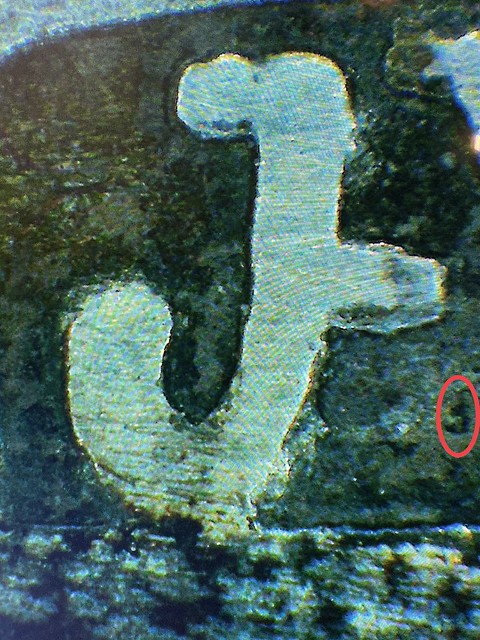 The first image at left is Wright’s “JL” with the circled hand cut “J” for junior. The hallmarked “IR” below is Richardson mark on a documented spoon, showing the additional “J” for junior
circled in black. The image showing “J.W” was punched on a 1792 Georgian barrel mustard pot. Made by Wyatt in London that year and not in Philadelphia. The only person with the Initials “JW” being
associated to the newly established US Mint, George Washington, including General Henry Knox in Philadelphia was Joesph Wright. Adding to the fact, we now have evidence that shows that both the
Woolaroc & NY hallmarked medals are in fact “JLJW” for Joseph Lovell Wright Junior.
The first image at left is Wright’s “JL” with the circled hand cut “J” for junior. The hallmarked “IR” below is Richardson mark on a documented spoon, showing the additional “J” for junior
circled in black. The image showing “J.W” was punched on a 1792 Georgian barrel mustard pot. Made by Wyatt in London that year and not in Philadelphia. The only person with the Initials “JW” being
associated to the newly established US Mint, George Washington, including General Henry Knox in Philadelphia was Joesph Wright. Adding to the fact, we now have evidence that shows that both the
Woolaroc & NY hallmarked medals are in fact “JLJW” for Joseph Lovell Wright Junior.
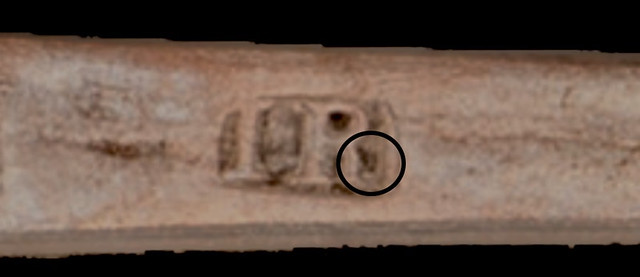
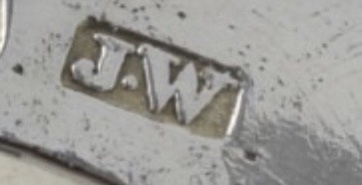
If readers are skeptical of this evidence, I can prove here that both the Woolaroc and NY medal were made by Wright. Wright was factually a Master Mason, his documented 1787 hand signed watercolor of a lady, visibly shows the numbers “47” that represents the numeric symbolism of a Master Mason. Called the 47th Problem of Euclid, simply being described in most Masonic books as a general love for Arts & Sciences that associates mathematic ratios with geometry. Wright cunningly transformed the nose of GW’s face on both the Woolaroc and NY medal as the number 47 that’s inverted. The NY medal with HDR camera imaging shows two more additional 47’s on opposite sides of the ground or field of the medal. The nose showing the 4 on the NY medal is slightly worn, but Wright adds an additional number 47 on GW’s cheek.
Regardless, after an exhausting research with trying to find Joseph's Masonic records, the signed, dated and documented work of Wright's water color of a lady in 1786, proves he was a Master Mason using the 47 symbolism in his art designs in an esoteric manner that the average eye does not see in plain view.
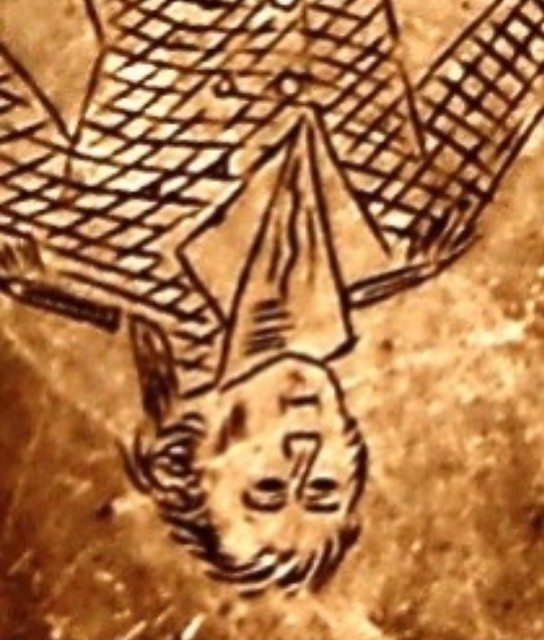
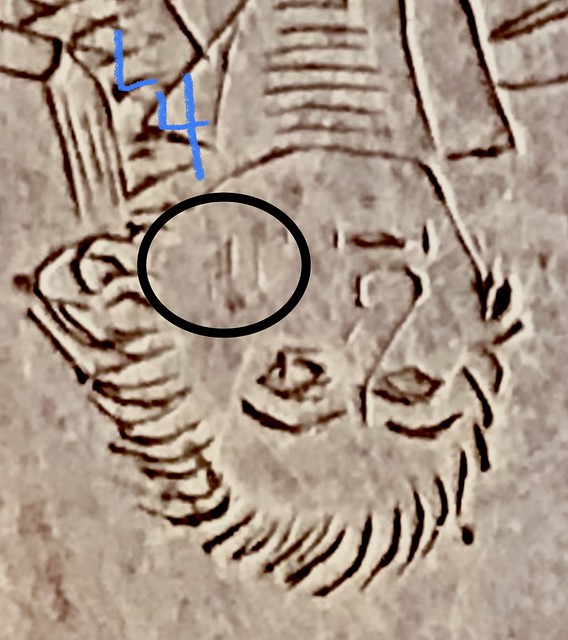
Images 1 and 2
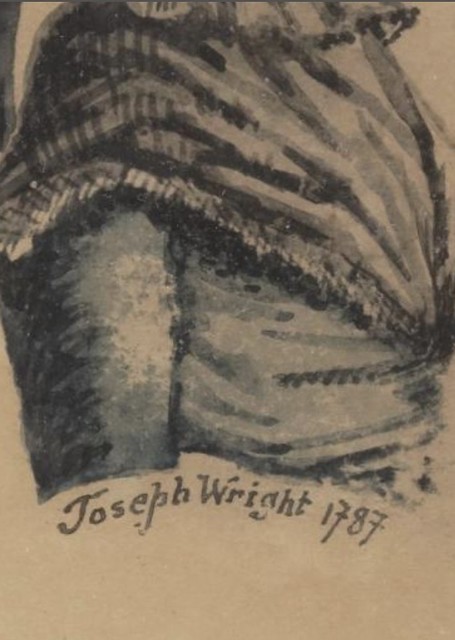
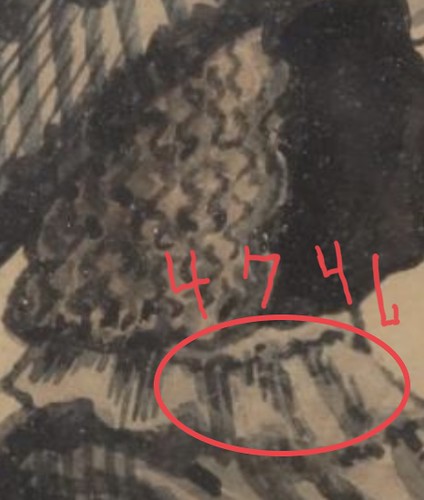
Images 3 and 4
The first image above is the Woolaroc medal, the nose shows the 4 as part of the 7. The second image is the NY medal with a faded 4 on the 7 (nose) with an additional 47 on the cheek circled. The next to images are Joseph's watercolor of the lady, showing exceptional numbers 4 & 7 in great detail. The NY specimens 4 on the cheek, to the right and inverted shows the number 7 in the identical manor as the second 47 on the water color of the lady. There is no disputing that these images are amazing finds.
Garth’s Auctions sold a silhouette of a Philadelphia lady that is signed and dated 1783 by Wright. Sold in Columbus, Ohio Sept, 11th 2015. Shows the only known identical JL like the hallmark ever found to date. The image is not of good quality and Garth’s is aiding in recovering a high resolution image of the maker mark for future documentation and additional provenance of the Wright medals.
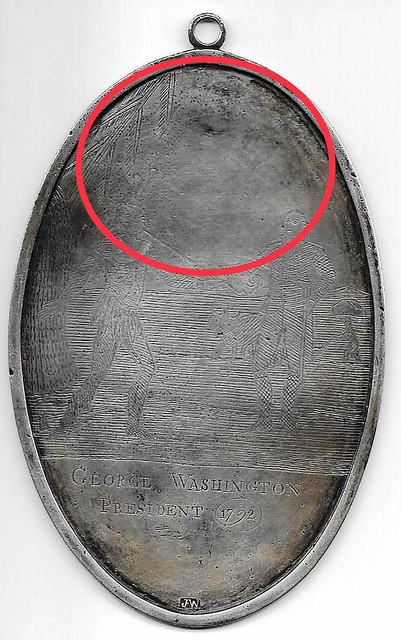
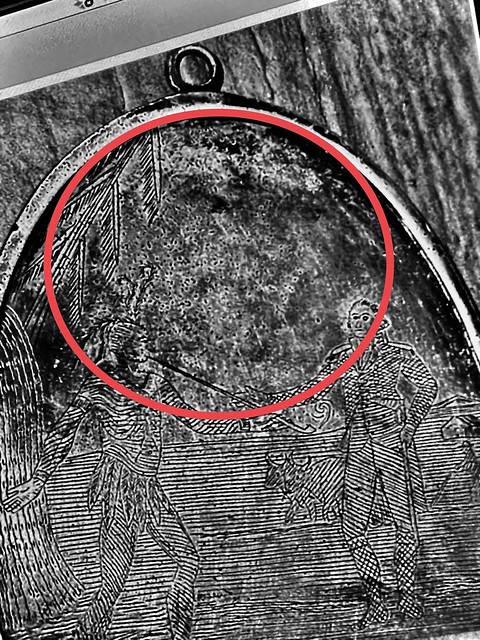
The images above show why Wright's engraving line work was not meant to be of quality like Richardson’s work. Wright focused his time on creating one of the most exquisite stipple piercing and shading portraits ever seen on a GW IPM. This is the first time the public gets to see what is believed to be the actual portrait of the recipient of the medal.
The NY medal has been XRF tested with period results by Bruker Corporation’s personal representative, proving the medals are authentic with no traces of chemical manipulation of the patina to show fake aging.
This February the NY, Wright medal was examined in hand by internationally renowned 9th generation silversmith Burt Boardman. Mr. Boardman’s forefathers were silversmiths before the 1750’s and established their family's company on the Connecticut river in 1789. The Boardman Silver manufacturing company is the oldest continuous operating silver company still in existence in United States history today. Mr. Boardman is one of the finest craftsman silversmiths living today, acknowledged by most all major auction houses as an authority on colonial silver identification, construction and silver manufacturing.
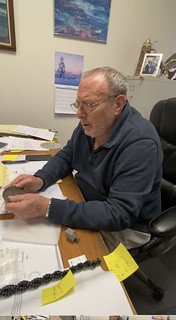 Mr. Boardman explained that the medal is a three piece construction and that because of the fine detail, Wright was trained to make his own tools to engrave the medal. The medal as he said
speaks for itself in being period and authentic. Boardman was video taped during the study to preserve the moment he had made his own major historical discovery on the medal.
Mr. Boardman explained that the medal is a three piece construction and that because of the fine detail, Wright was trained to make his own tools to engrave the medal. The medal as he said
speaks for itself in being period and authentic. Boardman was video taped during the study to preserve the moment he had made his own major historical discovery on the medal.
Boardman ran his thumb nail down the entire outside of the edge of the bezel and explained that the artist left an entire written cipher message on the edge of the bezel, all the way around the circumference of the medal. Boardman said, he could not translate the message, but is one of the few silversmiths today, who could authenticate that a written message is factually there. Messages of such on relics like this are an indication that the medal was very important. The message was either done by Wright or another silversmith.
Boardman’s last words on the medal subject were “numismatist catalogers of stamped coins and stamped medals, have no business acting as authorities with auction houses on what's real and what's fake, unless they have decades working as silversmiths themselves."
As always noted up front, The E-Sylm is a forum for numismatic discussion and not researched or independently fact-checked. Enlarged digital images present multiple problems, and controversy remains. As always, readers can click on images to see the full resolution original in our Flickr archive.
As with the results of the 1792 Half Dime study above, we'll await the next published report and additional images and evidence. Gary has shared with me other images too numerous to publish here. There is also more information on Gary's blog, linked below. I highly recommend the video of his visit to Boardman Silversmiths - their collection of silver trophies and awards is mind-blowing. -Editor
To read The Colonial Newsletter discussions, #159, see:
The Colonial Newsletter #159
The Colonial Newsletter #160
To watch the Boardman Silversmiths video, see:
The Last Of the Great American Silversmith’s
(https://americanrelichysteries.wordpress.com/2020/02/12/the-last-of-the-great-american-silversmiths/)
To read Gary's blog, see:
AMERICAN RELIC HYSTERIES Restoring History and Relic Values (https://americanrelichysteries.wordpress.com/)

CORRECTIONS: GROUVILLE HOARD DETAILS
Dr Philip de Jersey FSA is States Archaeologist for Culture and Heritage for the States of Guernsey provided these corrections to some of the facts about the Grouville Hoard in the article we excerpted last week. Thank you for the opportunity to set the record straight. -Editor
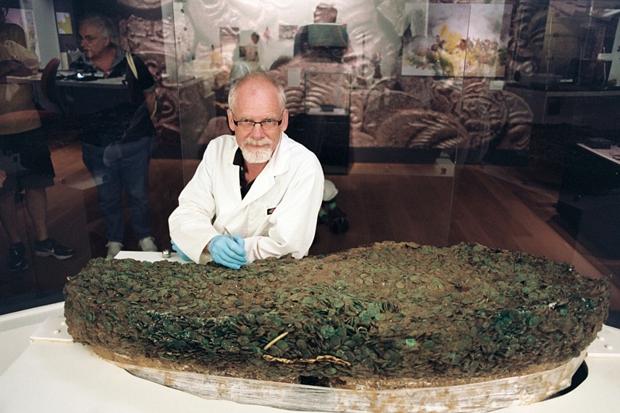
Neil Mahrer of Jersey Heritage with the hoard
A couple of corrections to the piece on the Grouville hoard – these PR type things seem to develop more errors as they get recirculated. At 69,347 coins this is far bigger than any other Iron Age hoard from the British Isles – probably 10 times or more bigger.
Of course one could argue about the relevance of the ‘British Isles’ to this distinction, since Jersey’s status as one of the British isles defies all geographical logic – at the time this hoard was buried it was politically and culturally closely linked to the continent, just a few kilometres away. Interestingly the next biggest ‘continental’ Iron Age hoard – also from Jersey – comes in at about 12,000 coins, so this one is still many times larger.
The hoard of 54,951 coins found more than 40 years ago in Wiltshire is the Cunetio or Mildenhall hoard mostly of late Roman low value bronze, and thus quite different in content to the Grouville hoard.
To say it was discovered ‘at a depth of only 3ft’ implies that it was shallowly buried, but it was not; it was only a very faint signal on the finders’ metal detectors that led them to discover it. And it wasn’t under a hedge, nor did it contain any Roman coins!
One final point – the total is an estimate, since a small block of the hoard has been preserved intact for future research, and although we can make a pretty good guess at the total number of coins in the block, it is still an estimate.
To read earlier E-Sylum articles, see:
https://www.coinbooks.org/esylum_v17n35a32.html (https://www.coinbooks.org/esylum_v17n35a32.html)
JERSEY GROUVILLE HOARD WAS TWO COLLECTIONS (https://www.coinbooks.org/v22/esylum_v22n12a24.html)
GROUVILLE HOARD SETS WORLD RECORD (https://www.coinbooks.org/v23/esylum_v23n06a24.html)
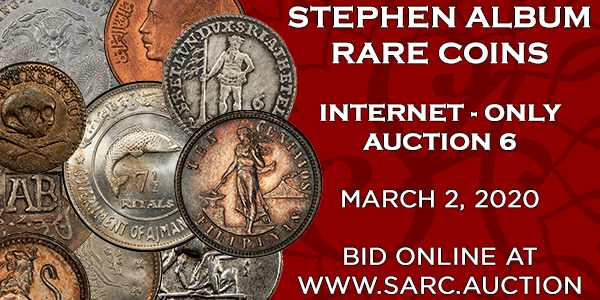
NOTES FROM E-SYLUM READERS: FEBRUARY 16, 2020
Sample Planchet?
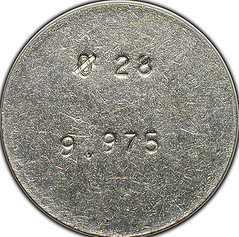
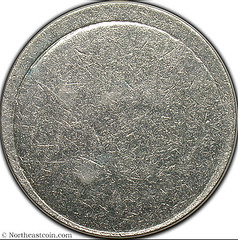
Craig Sholley writes:
"The 10F planchet in last week's E-Sylum appears to be a test or sample planchet. A Third Republic piece (1929 - 1939) has a diameter of 28mm and a weight of 10.0g. Could be simply a sample pulled for quality check."
Thanks. Neat little item. -Editor
To read the earlier E-Sylum article, see:
NOTES FROM E-SYLUM READERS: FEBRUARY 9, 2020 : Query: What Is This? (https://www.coinbooks.org/v23/esylum_v23n06a12.html)
Smithsonian Photo Caption Summary
Bob Steinberg writes:
"For sure that is Hans Schulman in the photo (he used to live in my apartment complex in NYC back in the 1960's)"
Andy Singer writes:
"I agree that the person on the right is likely Charles Hoskins, not Carl Carlson. In addition, I think the person seated at Elvira Stefanelli’s left is Karl Jaeschki, one of the museum staff who was there when I was an intern in 1967. It would be nice if we had a date for the photo. My guess on the date is c.1960-65. Elvira’s first edition of Select Numismatic Bibliography was published in 1965."
Howard A. Daniel III writes:
"I believe it is Carl H. Jaeschke sitting next to Mrs. Clain-Stefanelli. Carl passed away many years ago. I wrote to the Smithsonian Numismatic Department early in the 1908s requesting permission to go through the Vietnamese coins in their holdings. Carl sent me a letter and we set up dates and times for me. Carl lived in Turkey, which was considered to be Asia in the Smithsonian so he was put in charge of those coins.
"He knew very little about them so his first request to me was to sort out the Annamese (Vietnamese) coins from the many trays of cash-style coins. I recognized Vietnamese coins from several collections and I was able to weigh and measure many, many pieces to put in my database. It has been many, many years since I was last sitting at a long table with him and many, many large trays of Vietnamese cash-style coins. It was a great time for me."
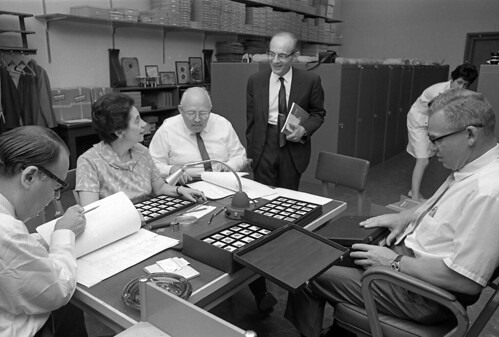
OK, we've had a lot of input over the past few weeks. Here's a compilation. There are five people at the table, and one still unidentified woman in the background, probably another Smithsonian staffer at work.
1st FROM LEFT: Hans Schulman (per Ken Bressett, David Alexander, Ken Bressett and Clifford Mishler, and Bob Steinberg)
2nd FROM LEFT: Elvira Clain-Stefanelli
3rd FROM LEFT: Carl Jaeschke, per Doug Mudd, Andy Singer and Howard Daniel.
STANDING: Dr. Vladimir Clain-Stefanelli
FAR RIGHT:
Not Abe Kosoff (per Julian Leidman, Ken Bressett and Clifford Mishler)
Possibly Carl W. Carlson (per David Alexander)
Probably Charles Hoskins (per Clifford Mishler and Andy Singer)
Thanks, everyone! -Editor
To read the earlier E-Sylum articles, see:
ELVIRA CLAIN-STEFANELLI AT THE SMITHSONIAN (https://www.coinbooks.org/v23/esylum_v23n03a16.html)
THE CLAIN-STEFANELLIS AT THE SMITHSONIAN (https://www.coinbooks.org/v23/esylum_v23n04a15.html)
NOTES FROM E-SYLUM READERS: FEBRUARY 2, 2020 : Photo Captions with Ken Bressett (https://www.coinbooks.org/v23/esylum_v23n05a11.html)
NOTES FROM E-SYLUM READERS: FEBRUARY 9, 2020 : Photo Captions with Clifford Mishler and David Alexander
(https://www.coinbooks.org/v23/esylum_v23n06a12.html)
Anne E. Bentley passed along this tweet from mudlark Liz Anderson. Thanks. -Editor
"There are some beautiful token moulds from centuries past, and mudlarks are always on the lookout for interesting bits of worked stone or clay on the foreshore. This token mould below is from the Roman period & is currently on display in the British Museum."
To read the complete tweet, see:
https://twitter.com/liz_lizanderson?s=11
The Numismatourist in Dubai
From the road, Numismatourist Howard Berlin writes:
"A funny thing happened to me on the way to the museum. Here in Dubai, I took one of the hop-on hop-off tour buses to get me close to the Coins Museum here. I got left off in front of the Dubai Museum, commemorating the first fort in Dubai from the 18th century. When I inquired how to get to the Coins Museum in the Fahidi Fort area from there, one individual, dressed in the traditional white ghutra or keffiyeh headdress with black igal headband and the long thawb – an ankle-length tunic. He indicated that he would be glad to walk me to the museum. It was not just around the corner and my knees and lower back were starting to ache.
This fellow then offered to bring his car around to drive me to the museum. I at first declined but only relented after he assured me that it was “no problem.” In about a few minutes, he arrived with his car and then proceeded to drive me to the museum. After I introduced myself and handed him my card and told him about my book about coin museums, he surprised me by telling me that he was the manager of the Dubai Museum! Talk about hospitality! In fact, in my first day in Dubai, I have encountered numerous instances of extremely polite courtesy towards me from the locals."
Stay tuned for future reports on Howard's travels! -Editor

AM I NOT A MAN AND A BROTHER TOKEN PEDIGREES
Saul Teichman is trying to sort some of the pedigree information on the "Am I Not a Man and a Brother" Hard Times token discussed last week. Can anyone help? -Editor
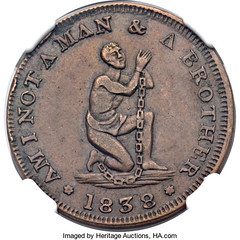
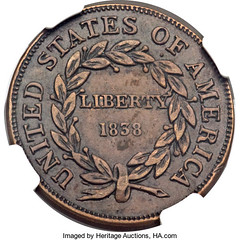
With regard to the Low-54a in last week’s E-Sylum, there are 4 known pieces.
I have been trying to sort some of the pedigree information on these.
Most of what is available is from Bowers & Merena’s 3/92 sale.
Eric Newman purchased that coin ex Hudson collection where it appeared as lot 45 with a pedigree listed as ex Lighthouse in the 1800s and later Ricard.
The Ford piece, lot 118 is Stacks June 2004 sale was described as being ex Hillyer Ryder and Boyd prior to Ford and is apparently ex lot 2177 in Elder’s 2/1920 sale.
The Bowers sale writeup does not match the Stack’s pedigree unless Raymond sold it to Ryder.
The Bowers sale also gives a pedigree to the discovery coin ex Miller collection.
Finally, the Bowers sale notes lot 563 in Lyman Low’s 12/20/1918 sale as a possible 4th example.
What the cataloger did not know was that it was purchased by Virgil Brand for $125 and entered into the Brand journal as #90750. It was described as the 2nd piece known at the time.
The Brand piece may be the newly discovered coin that Heritage sold in their September 2019 sale.
Does anyone know if the pedigree information in these earlier catalogs is correct ?
To read the earlier E-Sylum article, see:
VIDEO: AM I NOT A MAN AND A BROTHER TOKEN (https://www.coinbooks.org/v23/esylum_v23n06a07.html)
THE BOOK BAZARRE
BANK OF NEW YORK FUGIO CENTS IN LUCITE
Roger Siboni submitted these thoughts on a recent acquisition - a Bank of New York Fugio Cent encased in Lucite. Thanks! -Editor
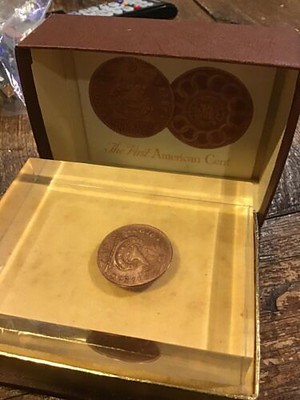
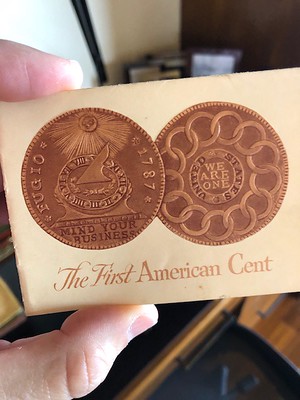
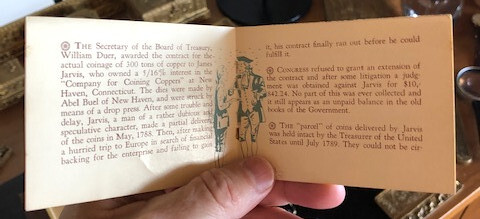
I was lucky enough to recently find a very nice original, in the box, with enclosed "Fugio history book", and related ephemera Bank of New York Lucite Fugio Cent on eBay. I have been looking for one of these in this kind of original condition for literally years.
I have seen about a half dozen at the most since the early nineties when I started looking. What I have noticed is that they came not engraved (mine), modestly engraved (Syd's), and heavily engraved (Byron's). They all seem to be positioned 1/3 from the top (for engraving) and all seem to be entombed at a slight angle (must have been something to do with how they were made). They all seem to be uncish Newman 13-Xs.
Looking at the date on Byron's, I am guessing that they were made in the early sixties. That seems right, the era of plastic....around the time of Dustin Hoffman and Mrs. Robinson....plastic is the future ;-)!
I have enclosed pictures of Byron Weston, Syd Martin, and my examples.
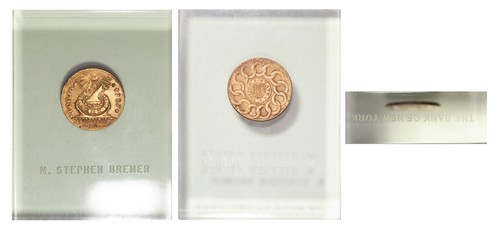
Syd Martin specimen
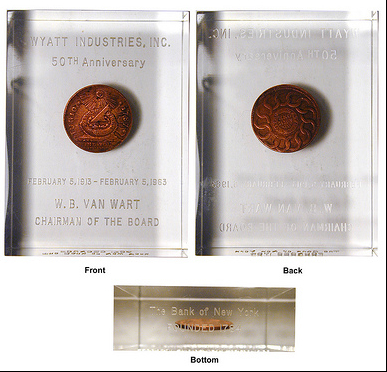
Byron Weston specimen
I would love to take advantage of our vast and numismatically literate E-Sylum audience to ask if anyone knows the real story on these. When were these made? How many?. For how long? Did they know what they were encasing was valuable (was it then?). About how many remain? I know I tried to acquire one through BONY in the early Nineties and they told me they ran out years ago.
Can anyone help? -Editor
To read the earlier E-Sylum articles, see:
LUCITE-ENCASED BANK OF NEW YORK FUGIO CENT HOARD PIECE (https://www.coinbooks.org/esylum_v11n26a17.html)
BANK OF NEW YORK FUGIO CENT IN LUCITE (https://www.coinbooks.org/esylum_v17n48a26.html)
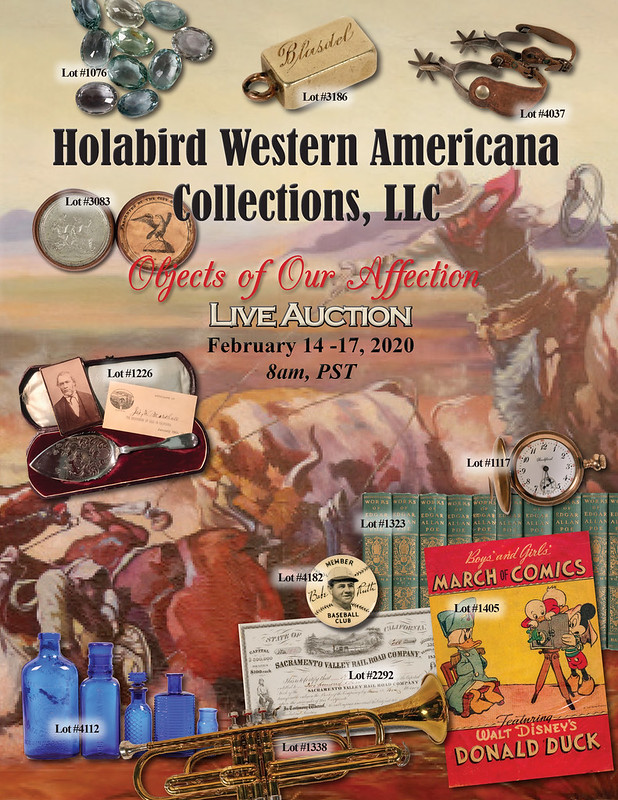
U.S. MINT 'HOW TO MAKE A PENNY' BROCHURES
Dave Lange writes:"I found two examples of this brochure within a lot of early COINage magazines. It was produced by the U. S. Mint in 1971 and was probably given out to persons taking the tour. I imagine it was printed in the tens of thousands or even more, but how many have survived?"
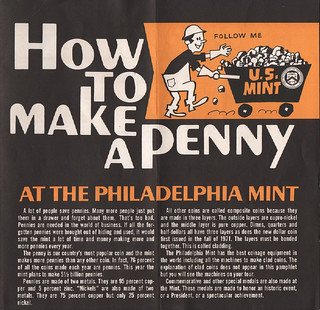
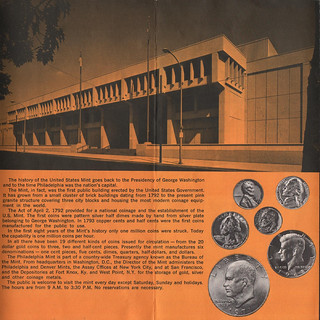
Front and back covers
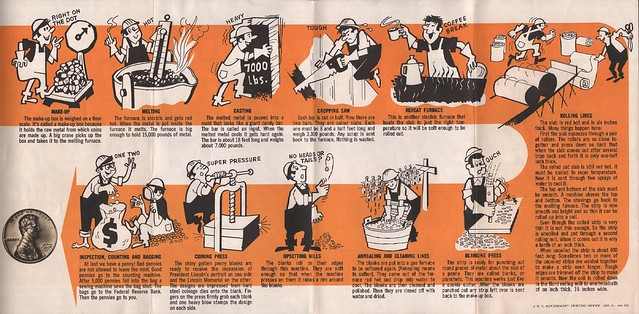
Inside spread
I don't believe I've seen this one before. It could well be a quite rare piece of U.S. Mint ephemera. Anyone out there have one of these? The Philadelphia Mint building is pictured, and the tour hours for just one facility are mentioned. I guessed there would have been a counterpart to this for the Denver Mint, and sure enough, there's one on the Newman Portal. -Editor
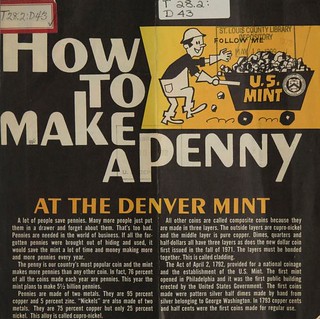
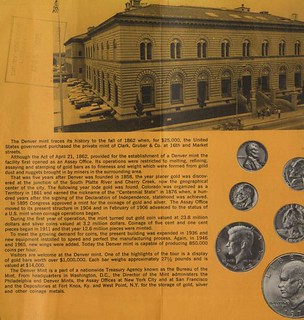
Front and back covers
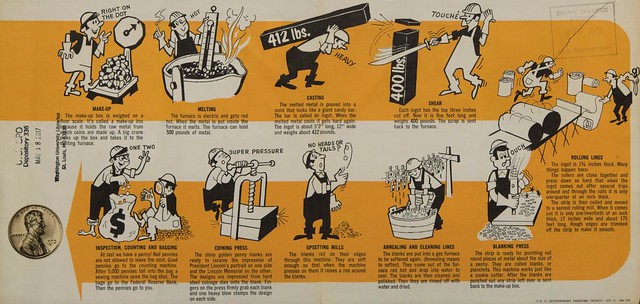
NNP Project Coordinator Len Augsburger writes:
"I think the one we have came from the Washington University government documents collection.
Dave contributed his images to the Newman Portal, so both the Philadelphia and Denver brochures are archived there now. Thanks, everyone. Numismatic ephemera is fun and interesting to collect, and many items are difficult to find today. The two brochures are clearly different, and not just in the names and pictures of the mints. The color is different, and the center cartoon is different in multiple places. -Editor
Dave adds:
"There would not be one for San Francisco, as it is not open to the public."
For the complete Denver brochure on NNP, see:
How to Make a Penny at the Denver Mint (https://nnp.wustl.edu/library/book/531278)
For the complete Philadelphia brochure on NNP, see:
How to Make a Penny at the Philadelphia Mint (https://nnp.wustl.edu/library/book/578187)

VOCABULARY TERMS: INSCRIBE, INSCRIBING
Dick Johnson submitted this entry from his Encyclopedia of Coin and Medal Terminology. Thanks. -Editor
Inscribe, Inscribing. To cut a line into hard material, as metal, to form a letter or design; flat engraving. The inscriber does not create relief but does engraving on a flat surface, often the reserve on an existing piece, as a medal requiring customized lettering for a particular recipient.
The word inscribe and its process is far overshadowed by the word engrave in current usage. The purist would say a person would inscribe a medal, but engrave a die. The engraver cuts away metal to form modulated relief, the inscriber does not change the relief but merely performs an engraving operation on an existing surface.
The tools used for both functions are the same, even the scriber – a sharp pointed hand tool to score or scribe a line on a metal surface – or the cutting point on an engraving machine produces only a fine line (particularly in drag engraving); also in acid etching lines are inscribed on the surface where a sharp pointed scriber removes the wax to acid etch a fine line. In the future we shall undoubtedly find the word “engrave” to include all the meaning of inscribe, the two words will probably never be differentiated, as, perhaps, they should be. See engraving, acid etching.
The area to be inscribed on a medal has special names. If the area is completely open in the design for that side it is called a RESERVE. If it is within a panel it is called a CARTOUCHE which is most often worked into the design. In at least one instance a medal designer, Frederick Ziegler, added a wide rim to the reverse of the Diamond Match Company Service Medal, where the recipient’s name could be inscribed.
For the characteristics of various metals for inscribing see the chart in the entry on engraving. Some medals are WORK HARDEND from striking thus may be slightly harder for inscribing than that stated in the chart.
Looking for the meaning of a numismatic word, or the description of a term? Try the Newman Numismatic Portal's Numismatic Dictionary at: https://nnp.wustl.edu/library/dictionary
Or if you would like a printed copy of the complete Encyclopedia, it is available. There are 1,854 terms, on 678 pages, in The Encyclopedia of Coin and Medal Technology. Even running two a week would require more than 19 years to publish them all. If you would like an advance draft of this vital reference work it may be obtained from the author for your check of $50 sent postpaid. Dick Johnson, 139 Thompson Drive, Torrington, CT 06790.
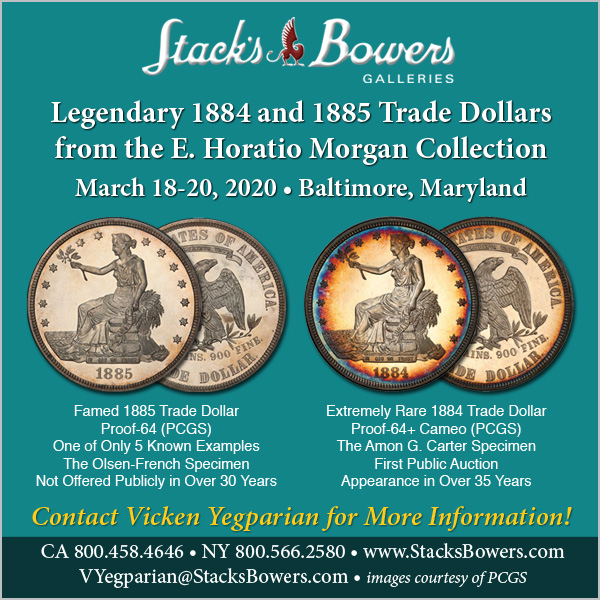
KARL "CHARLES" J. H. FUELSCHER (1863-1936)
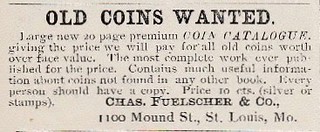 Karl "Charles" J. H. Fuelscher (1863-1936), was born on October 20, 1863, in Germany son of Karl Fuelscher and Wilhelmina Dyske Fuelscher .
Karl "Charles" J. H. Fuelscher (1863-1936), was born on October 20, 1863, in Germany son of Karl Fuelscher and Wilhelmina Dyske Fuelscher .
He immigrated to America as a teenager of seventeen in 1880.
In 1885 he worked as a clerk in the drugstore of Alban Treutler on the corner of Biddle and 13th Streets.
He soon made a start of coin dealing having published a twenty page Fixed Price List averring to be the most complete book of its kind ever for just ten cents in either silver coin or in postage stamps.
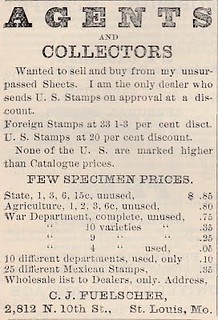 In 1888, he advertised in Curiosity World, large display ads selling postage stamps.
In 1888, he advertised in Curiosity World, large display ads selling postage stamps.
About 1890 he married Emeline J. Fuelscher (1870-1898). They had three children.
In 1898, his wife died shortly after the birth of their third child, Clara.
In June 1893, he began trading as The Anchor Stamp Company and notice was given in the June issue of The Post Office : A Monthly Journal for Stamp Collectors, on page 34.
In 1900, in the U. S. Census he is listed as a Dairy Solicitor, a widower, living at 150 Lee Avenue, St. Louis, with his mother-in-law and three children : Arthur (1892-), Helen (1895-1986), and Clara (1897-).
In 1910, in the U. S. Census he is listed working in the Tobacco and Cigar trade, living at 425 Athlone Avenue, St. Louis, with his three children.
About 1914 he married his second wife Hulda (1866-1956).
Apparently he became a career tobacconist selling cigars since he is listed as a partner with A. Otto Wiedmann in the firm of Fuelscher - Wiedmann Cigar Company with three stores in the 1920 St. Louis City Directory.
In the 1929 St. Louis City Directory he is listed as a cigar dealer working for the Jacob Lampert Cigar Company.
On March 21, 1936, at St. Louis, Missouri, he was found dead of asphyxiation from carbon monoxide poisoning either by accident or as an act of suicide which has never been determined. Perhaps his death was similar to that by accidental gassing of a fellow German dealer Ernst Franz Gambs. Otherwise he was like another German dealer, Wilhem Von Bergen, who took his own life in a similar way. He is buried in Bellefontaine Cemetery.
To read the complete article, see:
FUELSCHER, Jr., KARL "CHARLES"
(https://sites.google.com/a/numismaticmall.com/www/numismaticmall-com/fuelscher-charles)
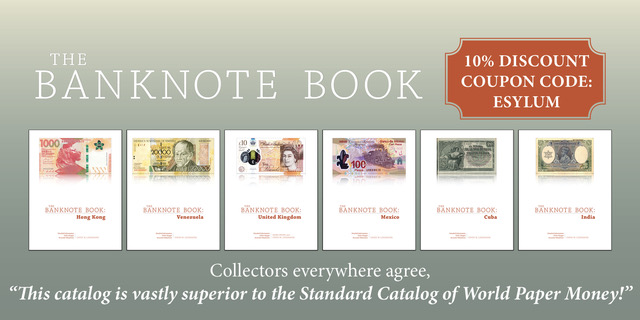
HARVEY STACK'S NUMISMATIC FAMILY, PART 63
The latest article in Harvey Stack's blog series is about the Snyder Collection at the Truman Library, and the death of Joseph B. Stack. Thanks, Harvey! -Editor
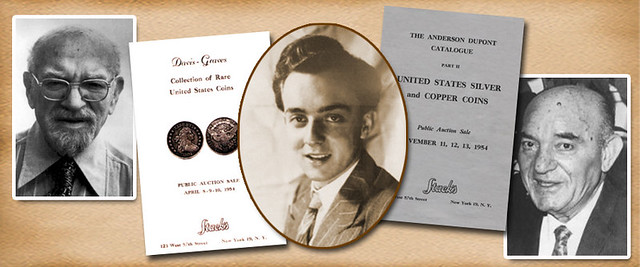
1974 was another great year for Stack's as we were able to continue to offer major collections at public auction as well as maintain our strong over the counter business. New collectors seemed to be entering the field, and Stack's was able to open new accounts for beginning collectors and young folk. We also kept working with advanced and dedicated numismatists who were enhancing their collections by acquiring rarities as they became available.
The hobby was able to encompass all levels, from those filling Whitman Boards with pocket change to specialists focused on building major collections. At the same time, there were people who were completing their collections, were fiscally unable to continue, or had passed away. In all these cases, Stack's had the knowledge and experience to help with our clients' needs, whether they were buying or selling.
The Hobby Protection Act providing some assurance that there would be more policing of counterfeits and copies, and the new numerical grading system offering another assurance. Collectors developed more confidence, started to expand their collections, and added some of the great rarities. It was a year that more major collections were being started and expanded, and the value of the collectable coins grew..
Stack's was fortunate and had nine separate sales during 1974, with many great rarities among the offerings. But first, I will tell of a sad development at Stack's and then of a great numismatic challenge that came our way beginning with an early morning phone call.
My uncle Joseph B. Stack took sick at his home in Palm Beach, Florida, and died in April 1974, at the age of 83. He was the older brother of my father, Morton (who had passed away suddenly in 1966) and the father of Benjamin and Norman. Joseph had been dedicated to numismatics for most of his life. He enjoyed being with collectors and traveling, making friends of collectors all over the United States. He was an incessant cigar smoker, always had a smile on his face, and truly enjoyed talking and visiting with clients in our shop, or on the road. Dealers liked him as well, for he was always fair in his dealings with them.
Uncle " J,B." was founded Stack's along with his brother and they focused solely on the coin business beginning in 1933. Among Joseph's many friends was John W. Snyder, secretary of the Treasury during the Truman years, who was an avid collector who loved the hobby. In fact, after Truman left office in 1952, Snyder promised the President that he would dedicate and provide a collection to be exhibited at the forth-coming Truman Library in Independence, Missouri.
The Stack family, working with Secretary Snyder, designed and furnished a full type collection, of coins used and issued during Truman's terms in office, an educational exhibit. In fact, Snyder brought President Truman into Stack's offices on West 46th Street to accept a group of coins for the display. Uncle Joseph was very proud to have had a president visit at Stack's.
When the Truman Library opened in 1958 , the Snyder Collection was a featured display. Unfortunately, about a year later, there was a break-in at the Library and the coin collection was stolen. All were heartbroken, and the Stack family decided to rebuild the collection, accepting public donations in cash or coins.. Within one year, a similar display was mounted at the Library, under more security, and it is still on display at the Library.
All of at Stack's were very sad to lose one of the firm's founders and a beloved family member. However, as always, those of us who remained, both family and staff, continued to do the work that was needed to build our business and the numismatic hobby.
To read the complete article, see:
Harvey Stack Remembers: Growing up in a Numismatic Family, Part 63
(https://www.stacksbowers.com/News/Pages/Blogs.aspx?ArticleID=harvey-stack-63)
To read the earlier E-Sylum article, see:
HARVEY STACK'S NUMISMATIC FAMILY, PART 62 (https://www.coinbooks.org/v23/esylum_v23n05a17.html)
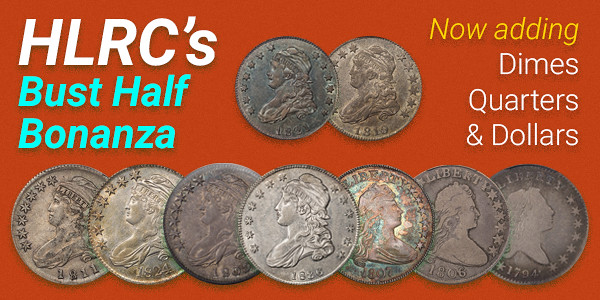
CALL FOR PAPERS: 2020 SUNDMAN SERIES
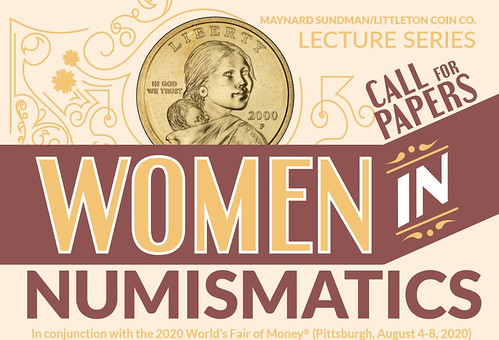
Women in Numismatics
The American Numismatic Association (ANA) is currently accepting proposals for the 2020 Maynard Sundman Littleton Coin Company Lecture Series. Presentations will be given Aug. 5 during the symposium at the Pittsburgh World’s Fair of Money®. Proposals must be received by April 3.
This year, Americans celebrate the 100th anniversary of the 19th Amendment to the constitution's passage that gave women the right to vote. In honor of this landmark event, the Maynard Sundman Lecture theme is "Women in Numismatics."
Those who wish to present at this year’s symposium must submit a lecture summary of 500 words or less. Each summary should contain an introduction, a brief discussion of the subject, sources and research method. Summaries will be reviewed and speakers evaluated and chosen based on originality, persuasiveness and relevance to the symposium topic. Selected presenters will receive a $250 honorarium.
Electronic submissions are preferred and can be emailed to seminars@money.org or mailed to:
American Numismatic Association
c/o Brianna Victor
818 North Cascade Avenue
Colorado Springs, CO 80903
Pittsburgh World's Fair of Money
The five-day Pittsburgh World’s Fair of Money, slated for Aug. 4-8, features nearly 1,000 dealers buying and selling coins, currency and related items; a wide range of seminars and educational presentations by notable numismatists; major auctions by Stack’s Bowers Galleries and Heritage Auctions; as well as exhibits showcasing priceless rarities from the Money Museum and private collections.
This is a great opportunity for researchers and authors. We've covered a number of relevant topics in The E-Sylum over the years, including women's suffrage tokens and medals, female models for coin designs, collectors such as Queen Lovisa Ulrika, Sarah Banks and Emery May Norweb, and dealer Catherine Bullowa. -Editor

SAN FRANCISCO MINT STRIP CAST / SHEARED INGOTS
Ken Conaway submitted this paper on the strip cast / sheared ingots of the United States Mint at San Francisco. Thanks! -Editor
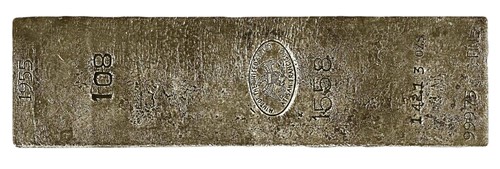
Mint Of The United States At San Francisco strip cast / sheared ingots have long been a mystery. Until discovery of the +/- 50-year-old Xerox copied photo above, all that we knew about these massive, strip cast ingots was derived from the sheared pieces, cut from these massive originals, as listed in the United States Government Silver Ingot Collection of Ken Conaway Registry.
The photo came to me from Clarence Criswell and represents a strip cast ingot, formerly in his collection, in its original entirety; 14 3/4” in length, 3 3/4” in width and 1/2” thick; serial number 1558 with Lot number 108; 142.13 ozs and 999.75 fine. The description is from the 1984 American Numismatic Association Convention Auction by Kurt R. Kruger in Detroit, Michigan on July 28 - 30, where Clarence sold his collection of United States Government silver ingots.
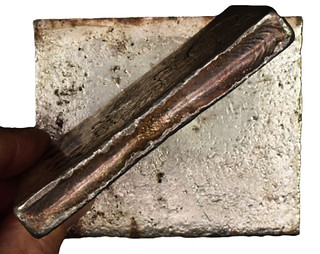 At about the same time that I received the photo and information from Clarence, I was able to acquire the example to the right. This is the first strip cast / sheared ingot I have seen that
shows an original pour end or top of strip casting.
At about the same time that I received the photo and information from Clarence, I was able to acquire the example to the right. This is the first strip cast / sheared ingot I have seen that
shows an original pour end or top of strip casting.
This is the same ingot shown in the top right on the comparison with similar markings to the top of the No. 1558 ingot in the photo received from Clarence. On the very top of the ingot, at the edge closest to the pour end, there is the date of 1955. Immediately below that is the Lot No. 53.
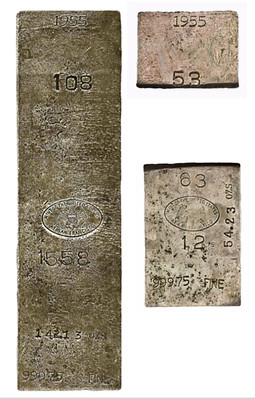 Obverse and reverse photos of this ingot are shown here. With the discovery of this photo and understanding of original ingot size and Mint Of The United States At San Francisco markings,
we can begin to interpret the markings that we find on strip cast / sheared examples. The large Type III Oval Hallmarks were not a reverse stamping of pre-cut material as previously assumed, but
rather the original, primary obverse hallmark stamp.
Obverse and reverse photos of this ingot are shown here. With the discovery of this photo and understanding of original ingot size and Mint Of The United States At San Francisco markings,
we can begin to interpret the markings that we find on strip cast / sheared examples. The large Type III Oval Hallmarks were not a reverse stamping of pre-cut material as previously assumed, but
rather the original, primary obverse hallmark stamp.
Discovery of the +/- 50-year-old Xerox copied photo shows that what was previously thought to be the reverse of strip cast / sheared ingot material, is actually the original obverse. In the comparison on the previous page of No. 1558 to the sheared examples on the right, we can see how original markings remain on some sheared ingot surfaces. Sometimes original markings end up on the reverse as we see in the top dated example; sometimes they remain the obverse as we see with No. 12. The upper righthand example on the previous page is the same as the first example on the following page. On this ingot we can see that a new Type II oval hallmark and all new makings were applied to the opposite side of the strip cast / sheared ingot.
With the second righthand example on the previous page, the original Type III oval hallmark remains. Possibly the serial number 12 and the added number 63 remain as well from the original. The fact that the original weight stamping is nowhere to be found causes the originality of the 999.75 FINE to be questioned; it might have been added after shearing. In the other examples on the following page, all new markings were applied to the reverse side of the original strip cast / sheared ingots, but telltale signs of original obverse markings remain on what are now the reverse surfaces.
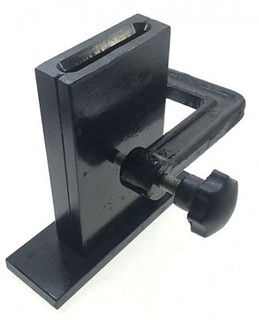 Through examination of photographs or handling of many of the examples listed in the United States Government Silver Ingot Collection of Ken Conaway Registry, I have long wondered what the
originals looked like that these sheared examples were cut from.
Through examination of photographs or handling of many of the examples listed in the United States Government Silver Ingot Collection of Ken Conaway Registry, I have long wondered what the
originals looked like that these sheared examples were cut from.
Not a United States Government Mint or Assay Office photo, but found online as a jeweler’s mold, we now know that these ingots were cast in a mold that would have been at least similar to the one in photo to the right. While the +/- 50-year-old Xerox copied photo sheds a tremendous amount of light on the mystery of strip cast / sheared ingots, it certainly raises other questions. Why would the Mint Of The United States At San Francisco cast +/- 150 oz ingots just to cut them into pieces? Why have we never seen even one original? Why would a delivery order as we see on the last page of this paper, be filled with sheared ingots rather than the original strip cast ingot?
Mint Of The United States At San Francisco strip cast / sheared ingots will continue to be a topic of my studies in search of more answers. As always, if anyone has anything to contribute, please contact me through SILVERINGOTS.COM or at kenconaway@aol.com
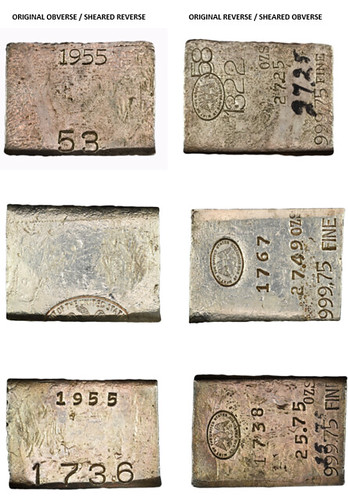

BLYTHBURGH HOARD DECLARED TREASURE
Arthur Shippee passed along this BBC News item found via The Explorator newsletter. Thanks. -Editor
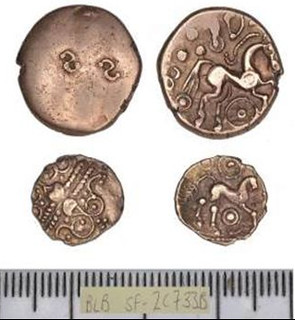 A hoard of 19 gold coins from the Iron Age unearthed in Suffolk was a "really unusual" find for the area, an expert has said.
A hoard of 19 gold coins from the Iron Age unearthed in Suffolk was a "really unusual" find for the area, an expert has said.
The collection was found on land near Blythburgh in February last year.
Suffolk coroner Nigel Parsley was told some of the coins had features linked with those traditionally associated with the north Thames area.
Archaeologist Dr Anna Booth said it showed "cross cultural interaction" between nearby counties at the time.
Mr Parsley declared the coins as treasure.
Dr Booth, a finds recording officer for Suffolk County Council, said it was a "really unusual hoard for East Anglia".
She said many of the gold staters and quarter staters were attributed to pre-Roman tribal leader Addedomaros, King of Trinovantes.
Dr Booth said coins associated with the Celtic ruler were more common in Hertfordshire, Essex, Bedfordshire, Buckinghamshire and Cambridgeshire, with relatively few in Suffolk.
One of the coins was previously unrecorded and "not seen before", Dr Booth told the inquest.
To read the complete article, see:
Blythburgh hoard: Iron Age gold coins declared treasure (https://www.bbc.com/news/uk-england-suffolk-51374440)

1830 TEMPLETON REID 2 1/2 DOLLAR GOLD OFFERED
This press release highlights an important pioneer gold coin in the upcoming Kagin ANA Auction sale. -Editor
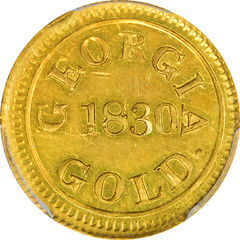
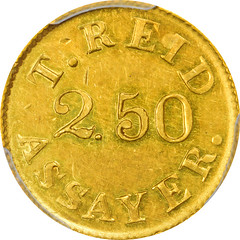
First Privately Issued Pioneer Gold 1830 $2 ½ Templeton Reid Highlights Kagin's ANA Auction
The finest PCGS MS-61 certified 1830 $2 ½ Templeton Reid pioneer gold coin is being offered in the official American Numismatic Association National Money Show auction by Kagin’s Auction on February 27th in Atlanta, Georgia. The privately issued mint state specimen was struck just a few miles away from the auction venue in Milledgeville as a consequence of the first major U.S. gold rush which occurred in the southern Appellation area of Georgia and North Carolina from 1828 through the 1830s.
At that time this underdeveloped area existed largely on a barter economy as precious metal coins were shipped to Europe or hoarded by the banks to pay import duties. These rich deposits brought new wealth to the area but it was difficult to use the gold dust and nuggets in trade and difficult to transport to the nearest mint in Philadelphia.
In July, 1830, Georgia metallurgist Templeton Reid became the first to answer this pressing need for an adequate medium exchange by melting down the gold dust and striking $2 ½, $5, and $10 gold pieces. Unfortunately, unsubstantiated allegations of the coins being underweight and unconstitutional eventually led to most of the coins being refused or melted and forced Reid to close down just a few months later, leaving a legacy of privately issued pioneer gold coins for more than 30 other merchants over almost 35 years to follow.
Other pioneer gold coins in the Kagin’s auction includes three other Georgia coins struck by Christopher Bechtler, California gold rush coinage highlighted by a mint state Augustus Humbert 1851 $50 gold “slug”, Mormon gold coins and coins from the Colorado gold rush including the iconic Pikes Peak $10. Shipwreck treasure highlighted by a 97.77 Kellogg & Humbert ingot are also offered along with ingots and nuggets.
Other numismatic series offered are Early American medals, U.S. Colonial and Federal coinage from ½ cents through gold.
U.S. Paper currency, Confederate Currency and Errors are part of Friday night’s session.
Also featured on February 28th are collections of Lesher Dollars, So-called dollars, tokens, good-for mirrors, Civil War, Hard Times and Political Tokens as well as over 250 U.S. Gold and Silver medals.
The sale concludes with over 75 lots of Odd & Curious/Primitive money from the Ken Hallenbeck collection including 7 Yap Stones, three Money Trees and a Chinese Ming Note.
Catalogs are available on-line at www.kagins.com or by contacting Kagin’s Auctions at 888-852-4467.
View the online virtual catalog at https://www.kagins.com/kagin-s-ana-auction-feb-27-29th-2020-atlanta-ga
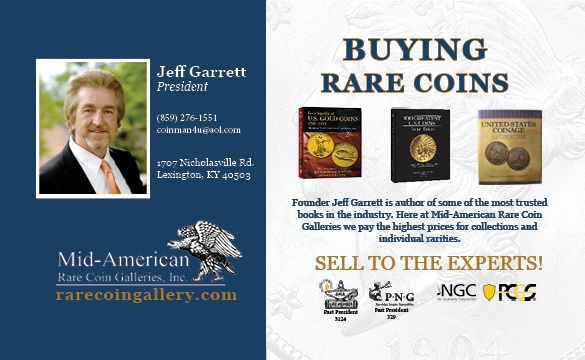
PATTERN COINS FROM CHARLES BARBER ESTATE
This NGC press release announces the appearance of five U.S. patterns from the estate of engraver Charles Barber. -Editor
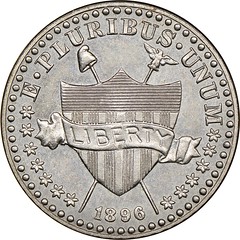
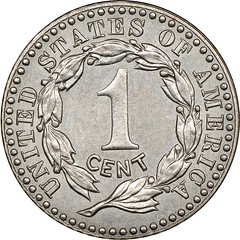
Numismatic Guaranty Corporation® (NGC®) has certified five 19th century US pattern coins that belonged to Charles E. Barber, the US Mint Chief Engraver from 1880 to 1917. A pattern coin is one that features a proposed design, composition or denomination.
Three of the patterns were designed and sculpted by Barber, while the other two were executed by his father, William, who preceded him in the role of Chief Engraver, serving from 1869 to 1879. The five pattern coins were submitted to NGC on behalf of their descendants.
William Barber served as 5th Chief Engraver of the US Mint from 1869 to 1879, and his legacy includes the US Trade Dollar, struck only for a short time to compete with other nations’ silver coinage in Asia. He also produced many patterns.
The first of the Barber Estate coins is an example of Judd-696 (attributed according to J. Hewitt Judd’s United States Pattern Coins). This 1869 Pattern Dime is struck in silver and is just faintly larger in diameter than half dimes of the period. Rated R-5 (31-75 known), it was graded NGC PF 63.
Judd-696 is an example of the Standard Silver series of patterns created in 1869-70. These were proposals for a silver coinage of reduced size and weight at a time when silver issues were trading at a premium to the greenbacks and fractional notes that dominated commerce. Ultimately, this plan was rejected, but it left a rich legacy of experimental strikes in various die marriages and compositions.
A second example of William Barber’s Standard Silver work is featured in the Barber Estate submission. This is an 1870 Pattern Dime, attributed as J-843, that is similar in its design elements but features an alternative version of the Liberty bust and wreath. Also struck in silver, J-843 is rated R-6 (13-30 known). It has been certified as NGC PF 64.
William Barber and his wife immigrated to the US from England in 1852, when son Charles was just 12 years old. Following William’s death, Charles was appointed his father’s successor as Chief Engraver. One of the most prolific coin engravers in US Mint history, Charles Barber lends his name to three series that began in 1892: a dime, quarter and half dollar.
Charles Barber also created a broad range of pattern coins, including a unique series of “holey” one-cent and five- cent pieces in 1884. Conceived by artist Eastman Johnson — perhaps as an aid to the blind — these coins with center perforations were never approved for mass production, and only rare patterns survive from this experiment.
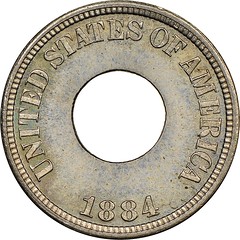
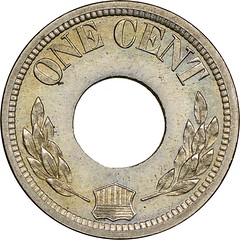
The Barber Estate submission includes two examples of Judd-1721 cents struck in nickel (rated R-5). These display a very simple design comprised of a wreath, a tiny shield and quite spare text. They are graded NGC PF 64 and NGC PF 65.
The final coin is an example of Judd-1767, an 1896-dated five-cent piece coined in nickel. It features an obverse displaying a shield somewhat similar to that on the reverse of current cents. This is paired to a reverse showing the national legend around a wreath that encloses the denomination.
The US Mint was not contemplating a change to the cent, and the dies were simply a test of alternative metallic compositions, including pure nickel. Certified as NGC PF 66, the most recent edition of the Judd pattern book reports seven known, making this newly revealed example the eighth.
“Numismatics is a dynamic field, and you never have to wait long for another exciting discovery,” said NGC Chairman Mark Salzberg. “NGC is honored to have certified these historic pieces from a family that had such a lasting impact on the coin collecting world.”
The coins’ NGC certification labels include the important pedigree of Charles E. Barber Estate. They were submitted to NGC by John Frost, a numismatic author and president of the Barber Coin Collectors’ Society, on behalf of great-grandsons of Charles Barber.

ROYAL MINT DINOSAUR COINS
Arthur Shippee forwarded this story about the Royal Mint's new dinosaur coins. Thanks. -Editor
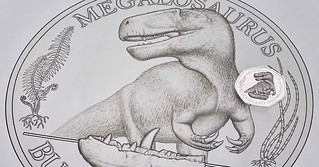 The Royal Mint is releasing three new dinosaur-themed coins - the first ever in the UK.
The Royal Mint is releasing three new dinosaur-themed coins - the first ever in the UK.
The series of 50p coins is a collaboration with palaeoartist Bob Nicholls and experts at the Museum. The coins will honour the first three dinosaurs found in modern-day Britain, and the first ever named - Megalosaurus, Iguanodon and Hylaeosaurus. Although at the time they were named, 'dinosaurs' as a group didn't exist. In fact, it was these three animals that made Sir Richard Owen realise that there was something different enough about them that they warranted being placed in a new group, which he named Dinosauria.
The three species will be featured on five series of collectors' coins. Although they will be legal tender, they won't go into circulation. Instead members of the public will be able to buy the coins, either individually or in sets.
Prof Paul Barret is a dinosaur researcher at the Museum who has been advising on the designs' scientific accuracy.
He says, 'It is exciting to do a project like this. Helping to approve the designs, look at the overall aesthetic and witnessing the production process, from the original thoughts about what might be included to seeing the finished coins, has been very satisfying.'
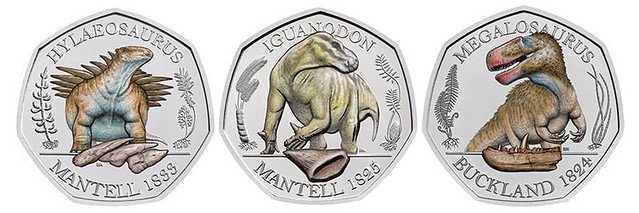
To read the complete article, see:
British dinosaurs to feature on UK money for the first time
(https://www.nhm.ac.uk/discover/news/2020/february/british-dinosaurs-to-feature-on-coins.html)
MEDIALIA EXHIBITS MASHIKO'S MEDALLIC SCULPTURE
Mashiko's Medialia Rack and Hamper Gallery in New York City is exhibiting her medallic sculpture work through April 18th. -Editor
SHALLOW RELIEF
MASHIKO
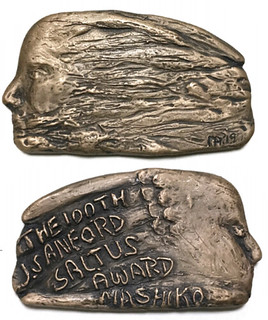 Contemporary medallic sculpture by Mashiko
Contemporary medallic sculpture by Mashiko
On its 100th anniversary, the 2019 J. Sanford Saltus Award for Signal Achievement in the Art of the Medal was presented to Mashiko. The American Numismatic Society recognized her as an outstanding artist, as well as for accomplishments as a gallery director, international curator, competition organizer, and promoter of contemporary medals for over 30 years.
Feb. 15th • 2020 through April 18th • 2020
For more information, see:
http://www.medialiagallery.com/
THE BOOK BAZARRE
CHINA DISINFECTS BANKNOTES TO STOP COVID-19
Banks in China are resorting to disinfecting and quarantining banknotes to help prevent the spread of the COVID-19 virus. -Editor
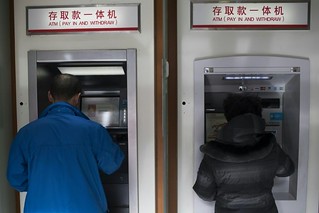 China is disinfecting and isolating used banknotes as part of efforts to stop the spread of the new coronavirus that has killed more than 1,500 people, officials said Saturday.
China is disinfecting and isolating used banknotes as part of efforts to stop the spread of the new coronavirus that has killed more than 1,500 people, officials said Saturday.
Banks use ultraviolet light or high temperatures to disinfect yuan bills, then seal and store the cash for seven to 14 days -- depending on the severity of the outbreak in a particular region -- before recirculating them, China's central bank said at a press conference.
The virus, which has infected more than 66,000 people in China and spread to more than two dozen other countries, has sparked a rush to disinfect public places and minimise contact between people.
Pharmacies across the country sold out of disinfectants and surgical masks in just days after a lockdown was announced in late January on Wuhan city, where the COVID-19 illness is believed to have emerged.
The central bank made an "emergency issuance" of four billion yuan in new notes to Hubei province, the epicentre of the outbreak, prior to the recent Lunar New Year holiday, Fan added.
The measures are intended to "secure the public's safety and health when using cash", Fan said.
But it is unclear how wide an impact the central bank's disinfection work will have, with increasing numbers of Chinese people preferring mobile payments over cash in recent years.
To read the complete article, see:
China cleans, locks away banknotes to stop virus spread
(https://news.yahoo.com/china-cleans-locks-away-banknotes-stop-virus-spread-055753358.html)
Robert Morris of Allentown, Pennsylvania passed along this Jakarta Post article. Thanks. -Editor
To read the complete article, see:
China cleans, locks away banknotes to stop virus spread
(https://www.thejakartapost.com/news/2020/02/15/china-cleans-locks-away-banknotes-to-stop-virus-spread.html)
LOOSE CHANGE: FEBRUARY 16, 2020
Here are some additional items in the media this week that may be of interest. -Editor
Inside the Bank of England Gold Vaults
Dick Hanscom passed along this BBC News video of a peek into the Bank of England's gold vaults. Thanks! -Editor
Bank of England gold: Rare look inside the vaults
The Bank of England’s gold vaults hold £194bn worth of gold bars.
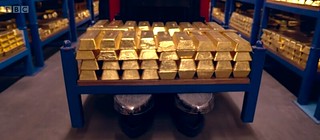 If you stacked them all on top of each other, they would be the same height as 46 Eiffel Towers.
If you stacked them all on top of each other, they would be the same height as 46 Eiffel Towers.
They hardly ever let anyone in to film, but the BBC’s Frank Gardner has been given access to the Bank of England’s gold vault.
To watch the video, see:
Bank of England gold: Rare look inside the vaults
(https://www.bbc.com/news/av/uk-51416500/bank-of-england-gold-rare-look-inside-the-vaults)
Hawaii Man Designs, Collects Elongated Cents
Michael Mochizuki has amassed a huge collection of pressed pennies.
"In my collection I probably have about 6,000 or 8,000," he said.
The technical term is elongated coins. They are one-cent pieces flattened by a machine that simultaneously squeezes and engraves an image into the coin.
“I learned from a website how to collect them, how to mount them and put them in binders, and which type of pennies to use because that matters,” he said.
Mochizuki also designs pressed pennies that are sought after by collectors. Since 2010, he’s created more than 300 different Hawaii-themed designs.
"I've done Hawaii statues, the historic Hawaiian railroad, I've done 20 different lighthouses and landmarks," he said.
Mochizuki takes photographs of places and things he wants to feature on a coin.
He sends them to a friend in Missouri who turns the photos into etchings and then presses the images onto pennies, a process called “rolling.”
"I feel like I'm contributing to a hobby," he said. "When I'm long gone somebody's going to pick up one of my coins and say, 'What's the story behind this?'
Mochizuki, 68, retired from a career in retail management. Now he has a lot of time to turn one-cent pieces into tiny works of art.
To read the complete article, see:
From retirement hobby to passion: Aiea man’s pressed pennies are tiny works of
art (https://www.hawaiinewsnow.com/2020/02/14/retirement-hobby-passion-aiea-man-turns-pennies-into-tiny-works-art/)

